





INDIAN LINK
PUBLISHER
Pawan Luthra EDITOR Rajni Anand Luthra ASSISTANT EDITORSheryl Dixit
MELBOURNE
Preeti Jabbal







INDIAN LINK
Sheryl Dixit
MELBOURNE
Preeti Jabbal
Speaking recently at a function in the UK, well known author Salman Rushdie touched on the theme of global migration.
ADVERTISING MANAGER
Vivek Trivedi 02 9262 1766
ADVERTISING ASSISTANT
Nitika Sondhi 02 9279 2004
DESIGN
Danielle Cairis
Indian Link is a fortnightly newspaper published in English. No material, including advertisements designed by Indian Link, maybe reproduced in part or in whole without the written consent of the editor. Opinions carried in Indian Link are those of the writers and not necessarily endorsed by Indian Link. All correspondence should be addressed to
Indian Link
Level 24/44 Market St, Sydney 2000 or GPO Box 108, Sydney 2001
Ph: 02 9279-2004
Fax: 02 9279-2005
Email: info@indianlink.com.au
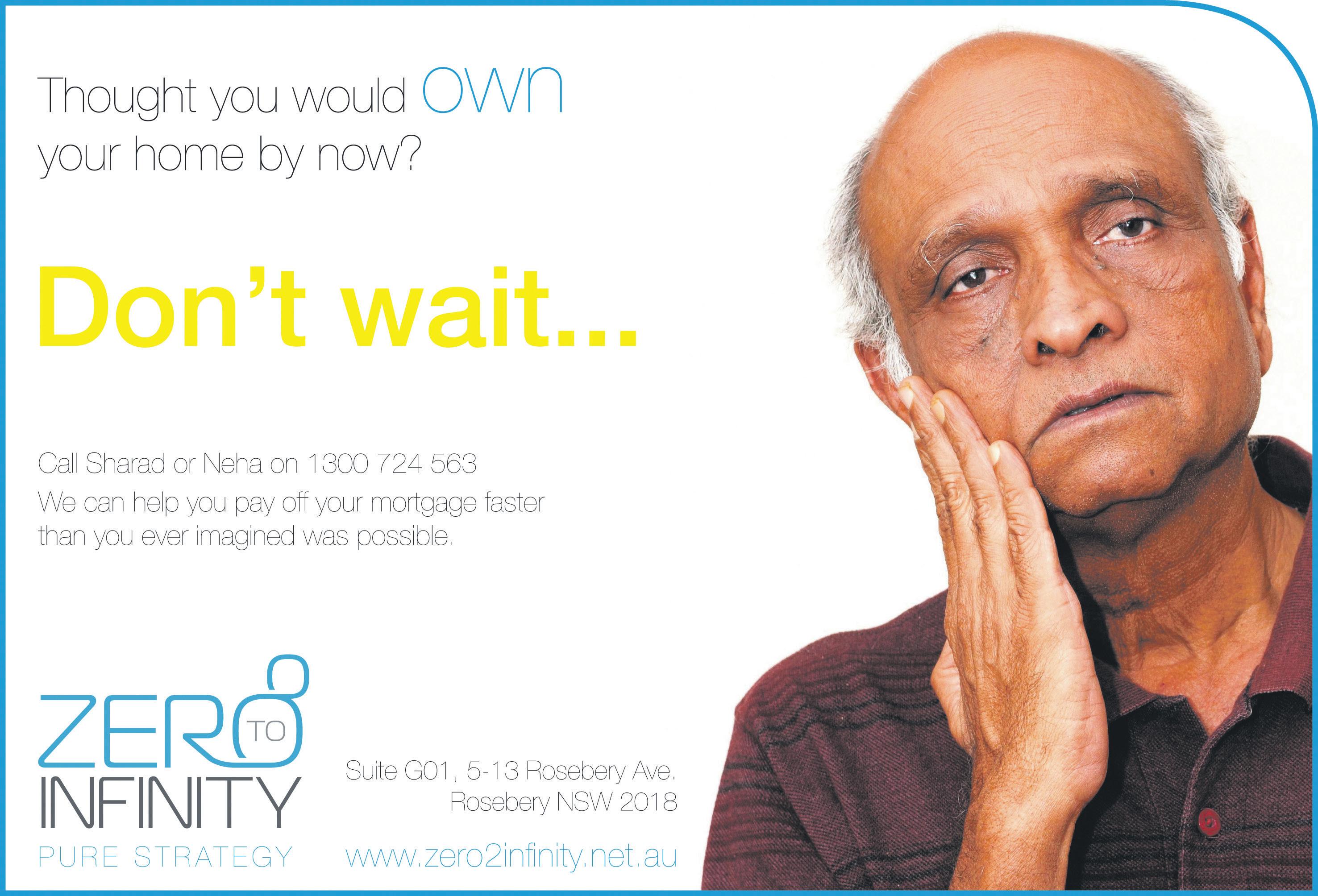
www.indianlink.com.au
“We live in an age of migration. There are more people now living in countries in which they were not born, than in the rest of human history combined.”
Rushdie’s observation on the flight of human capital between countrieswhether economic or political refugees or with family reunion motives - was that humanity is on the move, and will continue to be so for seemingly the better part of this century.
The world population of over 7 billion, combined with increasing awareness of what lies on the other side of the world thanks to the media, the internet and cheap travel, has allowed the exodus of people to take place much faster and in quicker time than in any other time of history.
This movement of people brings different sides of our characters to the fore, some of them good and others not so good.
Over the past few years, one has
come across a number of Indian entrepreneurs who have linked the business opportunities in their adopted country Australia to opportunities in India. On one side, there are those who, having lived here for a few years, have migrated back to India, established back offices in business processing in IT and now travel regularly to Australia to tender for business here for their teams in India. There are yet others, who have successful businesses in Australia but have over the past few years, set up back offices in India and so, while living in Australia travel regularly to use the skill set in India to provide services to their Australian customers. These entrepreneurs are normally young Indian migrants who are flexible and global with their approach in the business world.

Even at a more basic level, there are an increasing number of local travel agents who are setting up call centres in India for their basic travel enquiries: once the customer is won over, the tickets can be picked up from a physical office in Australia, which allows the customer to have assurance of a face-toface contact.
On the negative side, the arrival of new people in the country creates fear about job security and lifestyle changes for the existing community. As different cultures with different traditions, lifestyle, clothes, food, languages etc flood into the country, it is normal to feel concerned
about change in the social fabric. It is often left to the leaders to explain the benefits of the change and how the tapestry of society can be enriched. Sure, there could be initial teething problems but over a longer period, the strength in the local culture should be strong enough to absorb the habits and lifestyle of the new migrants.
Xenophobia can raise its ugly head as vested interests speak out against the new arrivals. In a veiled manner, this was experienced when the recent proposal to bring in 1,700 overseas workers raised the shackles of the Australian Union movement. Most of the leaders, themselves from Irish and Scottish backgrounds lost sight of the bigger picture behind this proposal and their reaction was hostile. That the Prime Minister of the country could not explain the benefits of this migration agreement, rather feigned ignorance, was criticized by all.
With global migration at this scale, the challenge will be for greater education about the benefits of these changes to society. Leaders need to speak out and play down the shock jocks who prey on the feelings of paranoia and xenophobia of the masses. At the same time, new migrants need to work hard in keeping alive awareness of their roots and appreciation of where they came from and yet, assimilate in their new adopted countries.
SPIRITUAL
Bhagavad Gita classes by SVT Learn Chapters 7 to 13 of the Bhagavad Gita as taught by Sri Vasudevacharya, a senior disciple of Sri Swami Dayananda Saraswati, and a respected Vedanta Guru. Darcy Road Public School Hall, Darcy Road, Wentworthville, 3:00pm to 5:30pm
No prior knowledge is required. The course is in English and all materials will be provided. The course is free of charge; donations are accepted. Details at www. srivasudevacharya.org
Shree Ram Sharnam society
The Shree Ram Sharnam society’s Sydney headquarters are located at 23 Sheba Crescent, South Penrith. One-hour prayer sessions featuring the recital of the Shree Amritvaani are held daily between 7:30pm and 8:30pm (except Saturday and Sunday when prayers are held from 6pm to 7:15pm). The society’s next prayer-meditation sessions are scheduled for May 13 and June 3 from 9.00am
to 10.00 am at the Woodcroft Community Centre on 65 Woodcroft Drive. Sanskrit lessons Chinmaya Mission Australia
announces a Beginners’ Sanskrit Course starting 31 May. The 10-session course, to be held weekly on Thursday nights, 6.30 pm to 7.30 pm, will involve Alphabet, Vocabulary, Basic Reading, Basic Grammar, Basic Conversation lessons. Details Br Gopal Chaitanya 02 8850-7400 or 0416 482 149
Children’s classes at GOD
The Global Organisation for Divinity announces the start of Gopakuteeram, spiritual educational classes for children aged 4 - 12 years.4.00 pm5.30 pm at the Crestwood Community Centre, Cnr Crestwood Drive & Chapel Lane, Baulkham Hills. Classes are free for all participating children. Parents can join in the devotional lecture by Sri Deepak Vinodji, kirtans and prayers in another room within the centre during the Gopakuteeram classes. Details
Sri Karya Siddhi Hanuman Puja
Sat 23 Jun Datta Yoga Centre will organise a Sri Guru Paduka Puja & Sri Karya Siddhi Hanuman Puja at Reg Byrne Community Centre, Cnr of Fyall Ave and Darcy Road, Wentworthville, NSW 2145 from 5:30pm onwards. Mahaprasadam will be served after the puja. Details Vikas Mohta 0434 218 587 or email info.dycsydney@gmail.com
MISC
Hindi studies for high school students
Hindi Language is offered by the Saturday School of Community Languages – DET at Liverpool Girls High School, Hills Sports High School and Strathfield Girls High School. This provides opportunities for high school students to study Hindi language to Higher School Certificate levels as it is not available at their day school. Board of Studies syllabus is followed. The classes are free of charge and are run
on Saturdays from 8.30 am to 10.30 am for Years 7 – 10, and 8.30 – 11.45 am for Years 11-12. Enrolment forms can be accessed from the School Principal of the mainstream school of your child or can be downloaded from www. curriculumsupport.education. nsw.gov.au/secondary/ languages/sscl/ Details 02 9886 7505 Saturdaycl-h.School@det.nsw. edu.au
Community health forum
Fri 22 Jun A community consultation forum sponsored by NSW Multicultural Health and aimed at building the health, energy and vitality of the Indian community, will be held at Hornsby Library Main Meeting Room, 28 – 44 George Street, Hornsby (Library entrance via Hunter Lane). 6.00 pm – 8.00 pm. All are welcome.
Details Shantha Viswanathan 0422 082 608
Sydney Sakhi Sangam
Sun 24 June Sakhi Sangam will be held this year at the Croatian Club. Details Nandini 0423 684
340, Sushma 0411 967 374, Aruna 0410 338 900.


Vision2020 Walkathon
Sun 15 July Sydney-based charity organisation Vision2020 announces a walkathon at the Lane Cove River National Park to raise funds for charity. The walk (Riverside Walking Track) is about 5km from end-to-end and 10km round trip. This is a family event and is suitable for people of all age groups and physical fitness. It is not a competitive event. People can walk at their own pace. There is no requirement for participants to walk the full or even a minimum distance. The Walkathon is in support of the following charities: Sri Datta Bal Sevashram (home for healthy children of leprosy patients and the homeless); Nand Gokul (orphanage), and Sandya Deep (old age home for the people - under construction)all three managed by the Swami Vivekanand Kusta Seva Samithi Trust, Gulbarga, Karnataka. Details at www.vision2020.org.au
over 22 years, we have helped 1000’s of satisfied clients to enjoy better health & healing using homoeopathic & naturopathic medicines. We specialise in Eczema, Acne & Psoriasis.



screenings program. Many of these film screenings include Q & A sessions with the filmmakers.
BY RAVI KAMBOJ2012 is already proving itself to be a great year for Indian cinema internationally. With a record Indian presence at Cannes this year and a few other awards to boast about, Indian filmmakers are soaring high!
Closer to home, Indian films are making their dynamic presence felt this year at the Sydney Film Festival with a

Anurag Kashyap’s eagerly awaited Gangs of Wasseypur 1 & 2, which made a big impression at Cannes this year, will be the first-ever Indian film in official competition at the Sydney Film festival.
Gangs of Wasseypur 1 & 2
Director Anurag Kashyap
An extraordinary ride through Bollywood’s spectacular, overthe-top filmmaking, Gangs of Wasseypur puts Tarantino in a corner with its cool command
audiences in the West. Split into two parts, this epic gangster story spanning 70 years of history clocks in at more than five hours of smartly shot and edited footage.
In the first half of the film, the early history of Faizal’s family is told, beginning with the rise of his grandfather Shahid Khan in the days when coal mines represented wealth and power. An omniscient narrator, who survives throughout the film, explains how, from time immemorial, Muslims have fought other Muslims in the area, not for religious reasons, but out of pure evil. Back in 1941, the mythic robber Sultana Daku looted British trains; he is later imitated by the sadistic Shahid Khan (Jaideep Ahlawat), who is eventually murdered by the young owner of



the coal mines, Ramadhir Singh, setting off a power struggle between the two clans that lasts till the final reel. Shahid’s hotblooded son Sardar shaves his head, vowing not to grow his hair until he exacts revenge for his father’s death. His passion for two women who will become his wives gives him a human, even comic, side. There are only four female characters in this boys’ club, all beautiful firebrands whose bloodthirsty ambition for their offspring would put Ma Baker to shame. Nagma, Sardar’s first wife, bears him four sons including the gangsters Faizal, Danish and “Perpendicular” Khan, while his Hindu wife Durga belatedly contributes the fearsome “Definitive” Khan. Each murderous son stars in a section of the story highlighting his outrageous misdeeds and amorous pursuits.
If the first half of the film sets the background to the present day,
Part 2 has moments of humour and is an easier, if certainly no less bloody, watch thanks to its many salutes to popular music and cinema. Sardar’s violence has made him the godfather, a role he keeps until betrayed at a gas station. His body, riddled with bullets, is carted away by his maddened son Danish, who goes on a rampage. But Danish isn’t smart enough to last long, and the family black sheep Faizal (Nawazuddin Siddiqui), a hash smoking pothead, climbs the ladder to power after cutting off his best friend and betrayer’s head. Taking his cue from Michael Corleone, Faizal modernizes the family arsenal and buys some new-fangled pagers that have just come on the market to communicate with his gang. Cell phones will soon be added. His courtship of Mohsina (Huma Qureshi) is one of the film’s non-violent high points. Addicted to romantic movies,
vignettes
from
Gangs of Wasseypur
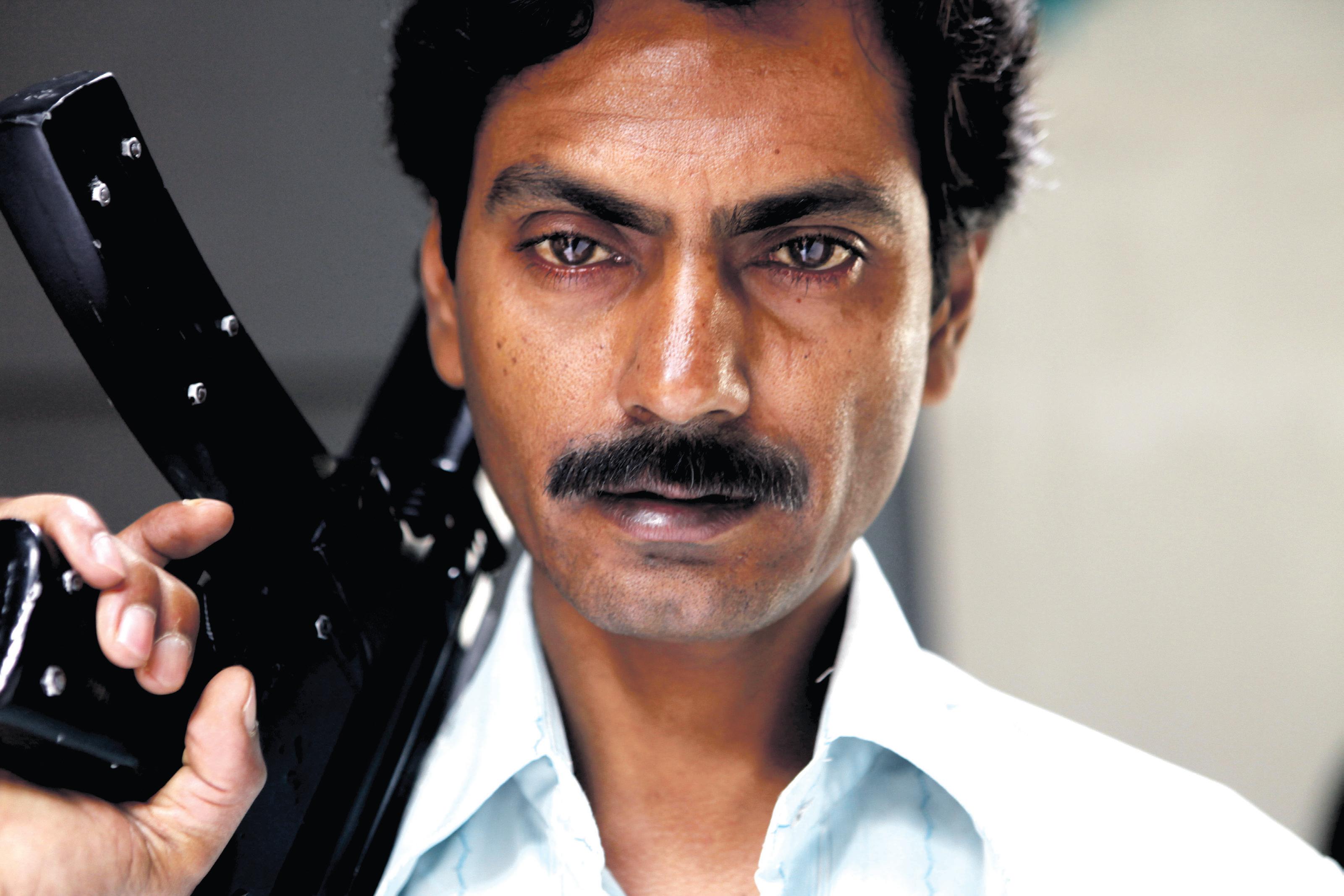
The Sound of Old Rooms
the lovely Mohsina looks like a Brooklyn moll and wears the same Ray Bans as Faizal, by which they recognize they are soul mates. Their sexy dialogue is a hoot, though the most blatant vulgarities are left to the lyrics (duly translated in the subtitles) to Sneha Khanwalkar’s sparkling score, pumped up with drumbeats at the first sign of gunplay.
It is now 2002 and Sardar’s strangely named teenage sons
Definitive and Perpendicular are ready to start their own violent careers, both defined by the narrator as “more terrifying than Faizal.” Their wanton killing sprees pepper the final scenes with death. Faizal is talked into going into politics, alarming his perennial nemesis Ramadhir Singh, now a corrupt old government minister. Their final reckoning takes place on election day as Faizal and his handful of loyalists lay siege to a hospital.
Kashyap, whose reputation as a screenwriter and controversial director reach a culmination in this film, is the real behind-thescenes godfather, never losing control over the story-telling or hundreds of actors, and allowing tongue-in-cheek diversions in the second half that confirm his command over the sprawling material. In the spirit of Bollywood, Rajiv Ravi’s lensing is

as Anand Patwardhan shows in his path-breaking film Jai Bhim Comrade (2011). Not only are we counting, but we’re counting cynically, calculating, dissembling, worried that we may accidentally dole out more than ‘they’ deserve.
Dr. B. R. Ambedkar was a hero of India’s oppressed Dalit (‘untouchable’) community.
When his statue in Mumbai’s Ramabai colony was desecrated
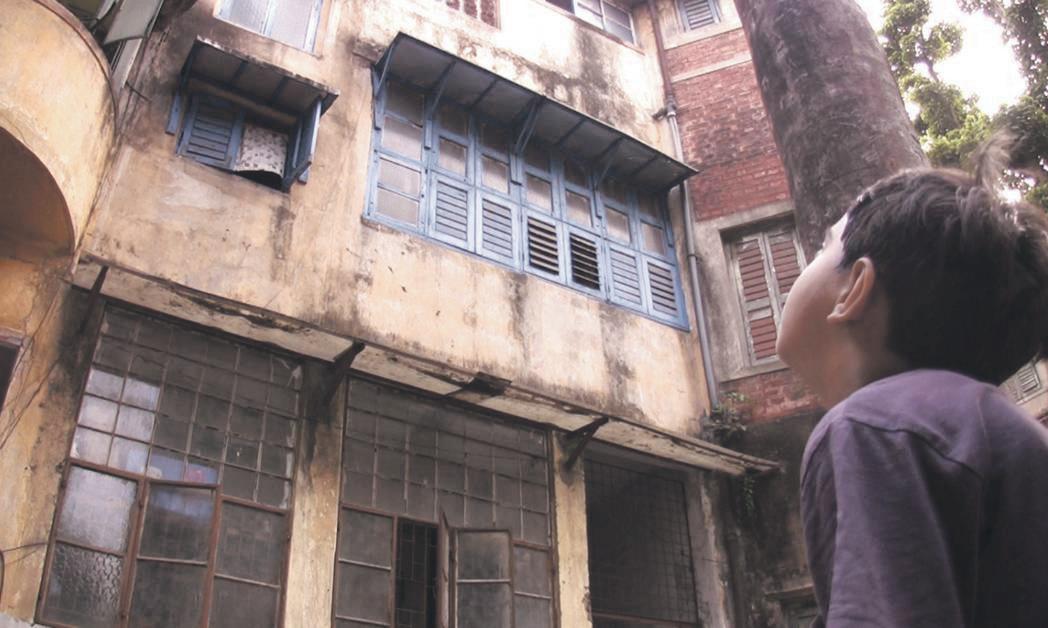
in 1997, angry crowds gathered. The police opened fire, killing 10 unarmed Dalits. Vilas Ghogre, an activist, poet and singer, hung himself in despair.

Anand Patwardhan - the acclaimed director of In the Name of God; Father, Son and Holy War and War and Peace (all three of which screened at past Sydney Film Festivals) - traces
The Temple Valley of Saints
Jai Bhim Comrade
the protest through the poetry and music of Ghogre and others. When asked why it took 14 years to make his film (which won the Firebird Award at the Hong Kong International Film Festival), Patwardhan replied, “I wanted to continue filming till all the false cases against the people in the colony were removed, or until the police officers who had ordered the firing were sent to jail”.
Director Anand Patwardhan will be present at the festival to introduce his film and will take Q & A after the film.
American filmmaker Musa Syeed directs a lyrical, tender film set on renowned Dal Lake in the disputed Indian state of Kashmir with this nimble debut feature.
Set on the beautiful Dal Lake in strifetorn Kashmir, the acclaimed Valley of Saints is an unlikely love story that raises important environmental issues. Gulzar is a working-class boatman who wants nothing more than to escape the violence and lack of opportunity. His carefully planned efforts to leave the region with his best friend Afzal are foiled by yet another curfew, and Gulzar is forced to remain. His humdrum existence is interrupted by the arrival of Asifa, a beautiful scientist who is researching the water quality of the Dal Lake. Gulzar ferries Asifa around as she makes ominous discoveries about the pollution levelsshould the problem go unchecked it could lead to the end of a way of life.
By most Western standards, Valley of Saints would barely be considered a romance – Gulzar and Asifa never actually go on a date, barely touch and never kiss. But in a culture that frowns upon unsupervised interaction between unmarried young men and women, the time that they spend alone together is an unanticipated opportunity.
Nonprofessional actors Bhat and Sofi have an easy rapport as the two young men and playing off Kashmiri actress Neelofar Hamid they create a convincing romantic triangle. The naturalistic performances complement the setting, with the majority of scenes shot on or along the lake.
Syeed, whose parents are from Kashmir, has directed several documentaries and his nonfiction experience proves apropos while working on and around the lake, shooting in cramped indoor quarters or aboard boats, mostly with available light. Setting his characters in their cultural setting and against the spectacular landscape, he favors minimal camera movement and fluid editing, picking up the pace when Afzal and Gulzar go into town or steal building supplies. The film’s bucolic mood is constantly threatened by the prevailing reality of violence and injustice in the region, a creeping tension that Syeed carefully calibrates to emphasize the tenuousness of his characters’ relationships.
The Alfred P. Sloan jury presented the Sundance award to the film for its “brave, poetic and visually arresting evocation of a beautiful but troubled region, and for its moving, nuanced and accurate depiction of the relationship between a local boatman and a young woman
scientist whose research challenges the status quo and offers hope for a restored ecosystem.”
Director Musa Syeed will be present at the festival to introduce his film and will take Q & A after the film.
Sandeep Ray
Sandeep Ray’s The Sound of Old Rooms, an exquisite Bengali documentary on a Kolkata poet, that was shot over 20 years, got a warm reception at the Dubai International Film Festival. Ray was mobbed by fans after the screening.
The Sound of Old Rooms is about how Sarthak Roy Chowdhury, a poet in Kolkata, struggles to keep the poetry in him alive even as he is consumed by the daily business of living - teaching, marrying, raising a son - and dealing with a constantly nagging but affectionate mother.
This deeply moving film evokes an amazing intimacy and empathy with the poet, his family, publisher, students and teacher, as well as the lively dark alleys of Kolkata and is remarkable for the way in which it celebrates the ordinary.
There are wonderful and funny moments, as when Roy Chowdhury goes for a walk in the night rain and reads his poetry to a dog; when his mother despairs that “this couple lives on just Maggi noodles”; and when his eccentric publisher says he enjoys nothing more than a good conversation, then coolly asks the poet to lend him some money!
“I decided to make a film on Sarthak mainly because he was very interesting and, as a good friend, I had free access to him,” says Ray.
The film begins when Sarthak was barely out of his teens, and concludes when he is in his 40s.
After shooting the film for 20 years, how did Ray know when to end it?
“We get a sense that his son Bhoon realises his father is a poet. He will remember his house, he studies in the same school as his father’s. Also, Sarthak seems to have become a more well known poet - we weren’t sure where that was going even as recently as three years ago,” says Ray.
Ray produced, directed and shot this 72-minute film on HD Cam. The film is co-written with Sarthak Roy Chowdhury, and co-edited with Subhadro Chowdhury, with evocative music by Sion Dey.
In a forgotten village called Mangrool that lies in the neglected areas of Maharashtra, years of bad weather and drought have taken their toll on the spirits of the villagers. One sleepy, run-of-the-mill afternoon, Kesha, a herdsman, has a divine vision (or so he thinks) of Shri Guru Dutta, who emerges from a nearby fig tree. Bewildered, Kesha runs through the village announcing the appearance of Lord Dutta to passersby.
News of Kesha’s vision spreads like wildfire. The village young guns think this event provides an excellent opportunity to make some long-
awaited changes in Mangrool. Soon, this becomes a matter of interest for politicians and the media. A decision is taken and many of the villagers are thrilled. A life until now only seen on television – the glitter of cities and a lifestyle the youth have dreamed of – will finally be theirs. The sleepy folks of Mangrool now get ready to build a huge temple to Lord Dutta in their village.
In his third feature film, director Umesh Vinayak Kulkarni considers the impact of modernization on a village whose inhabitants are rooted in tradition. The Temple pokes fun at the establishment, the media and politicians – all of whom want a piece of the glory that is on offer. Votehungry politicians go along with people’s beliefs – right or wrong – in order to get their support, while an over-enthusiastic media prints anything that will make saleable copy. Nuanced with local village politics, hopes and aspirations of youth, The Temple effectively depicts the irony of life in Indian villages.
If you’re after an Indian link that is less arthouse, you might prefer to come along and watch Mallika Sherawat in Despite the Gods (director, Penny Vozniak). A documentary about the making of the nagin film Hissss, the star here is not our dusky bombshell but the film’s director Jennifer Lynch, daughter of the renowned David Lynch, returning to film-making after a fifteen-year hiatus (as a recovering addict and a single mother). The camera follows the eight-month shoot, capturing the story of a woman struggling with expectations and compromises.

In the moving documentary Missing in the Land of the Gods the director Davor Dirlic follows anguished parents Jock and Di Chambers to India as they search for their son Ryan who went missing in 2005, last seen in the holy city of Hrishikesh.
The ‘new’ vs the ‘old’ is always a compelling theme while talking about India.
In director Nisha Punja’s The World Before Her, at the dichotomy from the standpoint of two different institutions – the Miss India contest and the Durga Vahini, a Hindu fundamentalist movement for women.
In the short film Unravel (director Meghna Gupta) we get inside the world of a Panipat rag trader who sorts through garments donated for charity by the West.
Below: Despite the Gods


 BY RAJNI ANAND LUTHRA
BY RAJNI ANAND LUTHRA
It will be all things cinema in Sydney as the 59th Sydney Film Festival gets underway this week. In a new look festival devised by firsttime director Nashen Moodley, cinema is going to come out of the theatres and invade other areas of life in our city, with exhibitions, talks, discussion forums, even cuisine, taking on the hues of silver screen.
“There’s been a wonderfully positive reaction so far to the program we’ve devised,” Nashen Moodley said while speaking with Indian Link a few days before the start of the festival, adding that he was confident of delivering a vibrant new festival.
More than 150 films from 50 different countries will screen at the festival which is on from June 6 – 17.
And while in recent years, Indian fare at the festival has dwindled somewhat, prompting comment in this very newspaper about the sorry inability of organisers to find even a handful of interesting films from the world’s most prolific filmproducing nation, this year’s special focus on India hopes to bring in welcome relief for
and contemporary India that struggles to make sense of itself as it grapples with centuriesold tradition and a modernity that is sweeping through it like a tsunami. This year’s Sydney Film Festival will take us from the rugged violence of the Hindi heartland to environmental degradation in war-torn Kashmir, from congested urban Kolkata to drought-ridden rural Maharashtra, from the glamour of the Miss India contest to the austerity of a Hindu women’s fundamentalist movement, from the sets of a Mallika Sherawat film to a Panipat rag trader’s workshop.
“Of course the Indian films are not only for Indian audiences,” Moodley noted. “The aim as always is to expose all our audiences to different types of cinema”.
And which of these films is Moodley himself looking forward to seeing again?
“I am loath to take sides really, but I’d say Gangs of Wasseypur and Jai Bhim Comrade Wasseypur will be interesting – full 5 ½ hours of it!
I’m just disappointed its director Anurag Kashyap won’t be here.
Still I’m happy we have the film in our official competition section – the first Indian film to be listed for competition at the festival”.
The competition section in general is one of the highlights for Nashen.
“Competition is important in a festival, I think,” he observed.
edge cinematic creations … rare but thrilling films that truly move the art form forward. These are the films that provoke, court controversy, broaden our understanding of the world and say important things in innovative ways”.

Equally important for Moodley are the film-maker guests who will be on hand to introduce their films, such as Anand Patwardhan, Sandeep Ray and Musa Sayeed from India.
“Guests also make the festival. To interact, network and engage with people involved with cinema at various levels, will be a definite highlight”.
And there will be many opportunities for film buffs to do this as the festival begins. This year, in a new platform created by Moodley, the Sydney Town Hall will be the ‘Sydney Film Festival Hub’. In just a short stroll away from the Festival’s major venues, the ‘hub’ will be a hive of activity where you can catch up with filmmakers as well as other festival goers, and enjoy free exhibitions, talks, parties, live music and performances. Discount tickets will be available for next-day screenings, and much like in New York’s Times Square, you will have experts on hand to guide you through what’s on offer.
Special events are also on at the Grasshopper Bar (one of them with Indian film-maker Musa Sayeed, where you can get
create special cinema-inspired meals! Plus, you can catch all the action at non-stop screenings of SFFTV at Martin Place.
With all these new activities, the Sydney Film Festival will look a lot more vibrant this year.
“Film festivals these days create a wonderful space for interaction,” Moodley stated. “The atmosphere is changed now, to include more consultation with the audience”.
But ultimately film festivals are all about films, and Moodley has created an interesting program, including new as well as established film-makers – a tribute to Bertolucci, classics from Japan, arthouse offerings from India, Indigenous films from Australia, films on music, “freak me out” films, international documentaries, short films, even a special section from Sydney’s film-school alumni.
At his first Sydney Film Festival, Moodley brings years of experience from the Durban and Dubai Film Festivals that he has been involved with for long. A film buff since his boyhood days, he stumbled on to organising film festivals during university in his native South Africa, where he was studying law. His family migrated from India in the 1860s, and although he continues to have close ties with India, Nashen claims he likes to see himself as a “global citizen”.

“I go to India fairly often, and have close contacts with the film industry there, having worked
and Dubai festivals”.
“I know an Indian focus has been largely absent in Sydney in recent years, and that’s what I’ve tried to shepherd in this year”, he added.
Some of the unforgettable Indian films screened at the Sydney Film Festival over the years have included Mr and Mrs Iyer (Aparna Sen), Peck on the Cheek (Mani Ratnam), Bend It Like Beckham (Gurinder Chadha), the documentaries Hunterwali (Riyad Vinci Wadia) and War and Peace (Anand Patwardhan), and a rare classic from 1928, Shiraz (Franz Osten and Himanshu Rai), restored and played to live orchestra music. Chadha and Patwardhan, whose films won SFF awards, were memorable guests of the festival, besides of course India’s undisputable star of ‘thinking’ cinema Shabana Azmi, way back in 1996. That year, Indian Link newspaper had helped organise a special night of Indian cinema with then festival director Paul Byrnes. Not long after that, Byrnes had included a list of Bollywood’s commercial blockbusters in the festival line-up. But the first samples of Indian cinema came to the festival nearly 45 years ago in 1968, when David Stratton brought Satyajit Ray and his Apu Trilogy to Sydney. With his special package from India this year, the message Nashen Moodley wants to send out to Sydney’s Indian

“Wasseypur will be interesting – full 5 ½ hours of it! I’m just disappointed its director Anurag Kashyap won’t be here. Still I’m happy we have the film in our official competition section – the first Indian film to be listed for competition at the festival”.
Nashen Moodley




Potential to earn +$100,000 p.a. while keeping your present job

Are you like most people who have studied various material on wealth creation, then got “fired-up” each time and pledged to go into business for yourself someday, but NEVER got around to it because you
• did not have the (large amount of) start-up capital that was required?
• Just couldn’t afford to give up your full-time job to do so due to existing commitments?
• Simply could not find the right opportunity (one with minimum outlay and maximum returns)?
If you are a motivated, self-starter who would seriously like to attain financial independence, earning a residual income with the potential to exceed *$100,000 p.a. in 2-4 years, starting part-time with relatively no financial risk, then call
(02)
And we’ll introduce you (without obligation) to one of the most lucrative business ventures of our time. This is a genuine, legal and high-integrity opportunity that is attracting people from all walks of life, including highly skilled professionals such as doctors, lawyers and business executives. It is definitely not for those looking for a ‘get rich quick’ scheme or rewards without effort-such things don’t exist.
Understand that if you don’t have, it’s because you don’t act. Call Now. (Serious enquires only)
CONTACT : DEEPIKA SHARMA

Avijit channels Talat Mehmood
drums), Sadiq (guitar) and Parag (side rhythm).
Sadiq also sang Tasveer banata hoon (Baradari) to show his respect for a great artiste who belonged to a generation before him.
One of the first songs that comes to mind when one thinks of Talat Mahmood is Jalte hain jiske liye and so it was no surprise when Avijit Sarkar opened his concert “Life and Music of Talat Mahmood” with this lilting melody from the film Sujaata. Story has it that the composer S D Burman originally intended to get Mohammad Rafi to sing the song but his assistant Jaidev suggested that Talat Mahmood’s velvety voice would be better suited to the song. Whether true or not, there is no denying the fact that the
song has become immortal and has immense appeal to audiences across several generations. Such is the magic of Talat Mahmood.
Talat Mahmood was known to be a soft spoken gentleman, a man with a distinctive mellow voice, stylish vocal expression and unparalleled emotional nuances in his singing. These are qualities also possessed by Avijit Sarkar which he proved once again on the evening of the 26th of May by presenting in his voice a range of songs originally sung by Talat in the 1950s and 1960s.
Avijit’s selection of songs for the evening highlighted Talat’s versatility in singing. He covered
a cross section of styles: ghazals, slow romantic songs as well as fast, peppy numbers composed by a range of music directors of that generation such as: Anil Biswas (Aye dil mujhe aisi - Arzoo; Rahi matwale -Waris), Naushad (Milte hi aakhen - Babul), Salil Choudhry (Aasoon samajh ke and Itna na mujhse -Chhaya; Raat ne kya kya - Ek Gaon Ki Kahani), Madan Mohan (Phir wohi shaam - Jahan Ara; Berehem aasmaan - Bahana), S D Burman (Jalte hain jiske liye -Sujaata; Jaayen to jaayen kahan - Taxi Driver), Ghulam
Mohammad (Zindagi dene waale sun - Dil e Naadaan; Dile e naadaan tujhe - Mirza Ghalib), Khayyam (Sham e gham ki - Footpath), Jaidev (Dekh li
teri - Kinare Kinare), C Ramchandra (Apni kaho kuchh - Parchhain; Bechain nazar - Yasmin; Muhobat hi na jo - Parchhain), Ravi (Sub kuchh lutake - Ek Saal), Sajjad (Yeh hawa
yeh raat - Sangdil), Shankar Jaikishan (Andhe jahan ke - Patita) and Sardar Malik (Aye gham e dil kya - Thokar).
Female vocals were provided by Pushpa Jagadish (Apni kaho; Itna na mujhse) and Rachna Bhatnagar (Milte hi aakhen; Dil e naadaan), both excellent singers in their own right. Pushpa Jagadish also sang Seene mein sulagte as her own tribute to Talat Mahmood.
Accompanying musicians that evening were: Akbar (keyboard), Abhijit (tabla), Salim (electronic

The evening was entertaining and the singing was interspersed with anecdotes from the life of Talat Mahmood. The audience, which included many who were not even born when the songs were released, seemed to love every minute of the concert and by the end of the evening were asking for more. This is a real tribute to a great artiste and to an era when melody and meaningful poetry ruled in Bollywood.

I hope that this love for classic Bollywood music does not fade and continues on in the hearts of the coming generations. The words of Majrooh Sultanpuri beautifully sung by Talat Mahmood come to mind: Geet nazuk hai mera sheeshe se bhi, tute na kahin.
The concert was sponsored by QualityCare and the ticket proceeds were donated to Breast Cancer Research in Australia.






















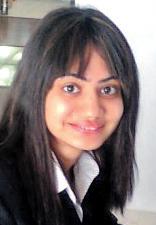














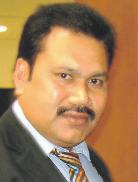




























‘It is the writer’s act of imagination which is the basis of all good fiction, the kind of fiction that opens new worlds to the reader. The power of literature to move people, allow us to see into one another’s hearts, to foster compassion and understanding and inspire political action works in a way that almost nothing else does.’ — Foreword to Alien Shores by Rosie Scott
Anew anthology of short stories, Alien Shores, Tales of Refugees and Asylum Seekers, edited by Sharon Rundle and Meenakshi Bharat and published by Brass Monkey Books is in full sail after not one, but four launches to send the book on its journey.

Alien Shores was launched by Mr Amit Dasgupta, Consul-General of India in Sydney on May 20, at a stellar event sponsored by the Hughenden Hotel. It is a collection of stories about refugees by Indian and Australian writers. Finding a person to launch a book is never a problem; the real achievement lies in having someone who has not only read the book but one who brings a unique understanding to it.
In releasing Alien Shores, the Consul-General’s speech showed such unique understanding. While discussing the stories, Mr Dasgupta acknowledged the gravity of, and showed great empathy for, a world with a moving mosaic of refugees. He spoke of the need for us all to show humanity and how easily any one of us could be thrust into similar situations. Remarkably though, Mr Dasgupta also included experiences of warmth, generosity and humour.
Linda Jaivin, Andrew Y M Kwong, Abdul Hekmat, Michelle Cahill, Susanne Gervay and Rosie Scott treated the audience to readings from their contributions to the book. Editors Meenakshi Bharat and Sharon Rundle spoke
about discovering their theme and collaborating to bring these stories from Australia and the Indian subcontinent together in a transnational collection. Roanna Gonsalves, as MC with flair, kept the launch moving at just the right pace. Other authors attending included David Malouf, Devika Brendon, Libby Sommer, Mabel Lee, Jacquie Everett, as well as film and theatre producers Ana Tiwari and Neel Banerjee. The official launch was followed by a lively afternoon tea to meet the authors and editors who happily signed books.
Alien Shores is published by Kabita Dhara of Brass Monkey Books, a fantastic new imprint showcasing the distinctive style and cadence of writing from the Indian subcontinent, much of which has never been published outside of India.
Alien Shores was also launched in Melbourne at Readings Bookstore at which Julian
Burnside QC gave such a moving speech that one could have heard a pin drop. Author Susanne Gervay OAM said that she ‘felt overwhelmed by Julian’s description of a refugee who converted to Christianity and would have been stoned brutally if forced back to Iran’.
Arnold Zable read briefly from his story The Dust of Life, followed by author and poet Ali Alizadeh who spoke about the unique perspective of his story before treating the audience to a short reading from The Ogre Sharon and Meenakshi revealed yet more stories of the process of bringing the stories out. Authors Jen McVeity, Hazel Edwards, Meredith Costain, Paul Collins, Rose Inserra, illustrator Marjory Gardner were also present. Gosford Library Services organised a preview launch at their Erina Library on the NSW Central Coast. Guest of Honour, Deb O’Neill, Federal MP, gave
an impassioned speech about the theme of the book. Her deep understanding and recognition of the purpose of the book and the individual stories within, as she launched the volume had the audience spellbound. Andrew Y
M Kwong, Michelle Cahill, Julia Mackay-Koelen attended the launch. Editors Sharon Rundle and Meenakshi Bharat talked about the importance and value of the stories by authors from India and Australia in Alien Shores. Well-known local doctor John Caska, was MC to introduce the guest speakers.

Gloucester Writers’ Festival launched Alien Shores during their warm and friendly lunchtime event. The festival featured writers Michael Wilding, Lisa Heidke, Lisa Walker and Susanne Gervay, who was keynote speaker. Andrew Y M Kwong and Sharon Rundle read from their stories. Sharon spoke about the genesis of the book and Susanne gripped the audience
with her story of her refugee background.
Alien Shores presents nineteen remarkable stories from acclaimed writers based in Australia and the Indian subcontinent which ruminate on the lives of refugees and asylum seekers all over the world. Powerful, poignant and sometimes funny, they tell the tales of brave people who, at great peril to their own safety, seek out a new life in a new land.
The contributors are Deepa Agarwal, Jamil Ahmad, Ali Alizadeh, Meenakshi Bharat, Michelle Cahill, Susanne Gervay, Amitav Ghosh, Abdul Karim Hekmat, Linda Jaivin, Tabish Khair, Anu Kumar, Andrew Y M Kwong, Julia Mackay-Koelen, Sophie Masson, Joginder Paul, Sharon Rundle, Sujata Sankranti, Bijoya Sawian and Arnold Zable. Alien Shores is available in all good book stores in Australia.

Asmall but influential group of NSW Parliamentarians and community members gathered to bid adieu to Indian Consul General Amit Dasgupta at the NSW Parliament House Jubilee Room. With wall to wall books and photographs depicting the story behind the establishment of the colony of New South Wales, Amit Dasgupta, well known for his love of all things literary, would have appreciated this unique combination of history and politics all coming together as he is one of the few Indian diplomats to be farewelled in such a public manner at the NSW Parliament House.
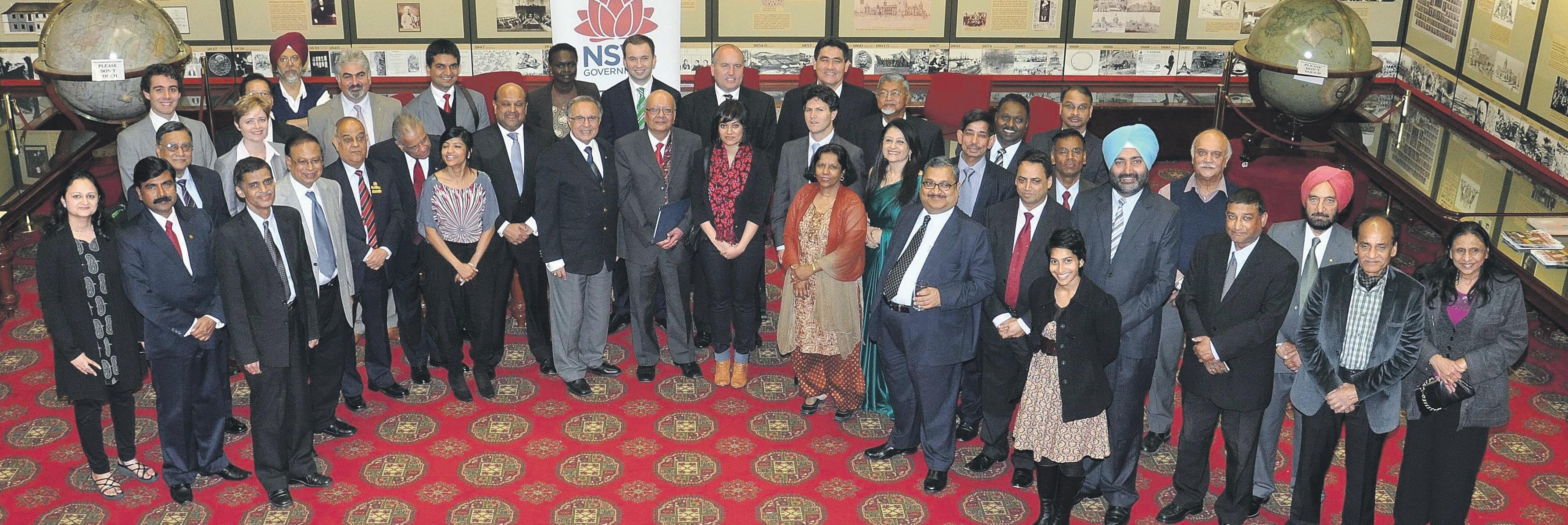
Those in attendance included Minister for Citizenship Victor Dominello, Member for Hornsby Matt Keane, Chairperson of Community Relations Commission
Stepan Kerkyasharian, Chair of the Multicultural Business Advisory Panel Nihal Gupta, UIA President Amarinder Bajwa, Bawa Jagdev OAM from the Sikh Council, Mala Mehta OAM from the Hindi school, Shubha Kumar from India Club and other leading community members.
Speaking on the occasion Nihal Gupta, Chair of the Multicultural Business Advisory Panel, spoke about the passion which Amit Dasgupta brought to his job, extolling his virtues of a global citizen. “He is an amazing person - an author, a diplomat, a terrific chess player, a fantastic chef, a man who is loyal, intelligent, wise and dependable. The NSW government has got to love him and appreciate the qualities he brought to his job”, Gupta told all.
Taking the role of Matt Preston, Nihal Gupta presented Amit Dasgupta with the ‘Indo NSW Master Chef award’.
Victor Dominello also spoke about the special bond which he shared with Amit Dasgupta and about his leadership as Consul General of India in NSW. “He is a provocative speaker and a true leader”, Dominello said. Keeping in line with these sentiments, Stepan Kerkyasharian also reminded all that Amit Dasgupta took up his appointment at the same moment that public controversy erupted over a spate of alleged attacks
on Indian overseas students in Melbourne and Sydney and as how from the beginning, Mr Dasgupta responded with candour, dedication and energy. “He went wherever he was needed, sometimes at short notice, and spoke always with great authority. His swift and decisive action, working in close cooperation with the CRC, played a significant role in demolishing the controversy within days,” Stepan said.
Making his last public speech at the Parliament House, Amit Dasgupta himself spoke about the challenges of those days and how it became important to separate the information from the misinformation which was around both within the local Indian community, the Australian community and in India. Answering a question raised earlier in the evening of “why we do what we do”, he said that his personal way of tackling this was to get a deeper understanding of what his own core values are and then as to what is the right thing to do.
“Once you have clarity on this,

then it is easy to do what you have to do,” he said.
For the local Indian community, he urged them to mix more with mainstream Australia and enjoy the multiculturalism of Australia.

It will not be an understatement that the three years that Amit Dasgupta has been the Consul General in NSW have been tumultuous years for the local Indian community. With screaming headlines and frenzied media reports of attacks against Indian students, street marches by Indian students in Harris Park grabbing front page news, it was a baptism of fire for the newly arrived diplomat. In an interview with Indian Link Radio and this newspaper, one year into his term, Amit Dasgupta discussed his desired accomplishments upon completion of his tenure. In 2010, he had wanted to increase trade between India and Australia. Two other tasks he had set for himself included setting up an International Students’ Centre and offering travel concessions for students. He also wanted to increase community
awareness of Indian establishments underpaying Indian students. “I also want the Indian associations to work together on community based matters and for the Indian community to take itself seriously,” he had said in his 2010 interview. Looking back, while trade has increased between NSW and India, the rest of the vision still needs time to be completed. The community has more robust organisations, often competing for political and public patronage; the Indian student revenue, albeit declining due to low numbers, has still to convince the successive NSW governments to offer travel concessions. There is however greater respect for all things Indian at various universities such as Macquarie, Sydney and New South Wales with the establishment of various chairs to understand and promote India. For Amit Dasgupta, a diplomat well known for his love of things academic, these would be the cherished achievements of his tenure in Australia.
 Pawan Luthra
Pawan Luthra




It was a memorable evening for four IT students attending the CeBIT ICT Dinner and Awards night on May 23, as they were each presented with the NASSCOM Innovation Student Award (NISA) for excellence in innovation in the field of information technology. The winners carried away a trophy, a certificate and $1000 in cash for their contributions to NASSCOM Australia’s inaugural awards specifically tailored to encouraging and supporting creative innovation in ICT students across universities in Australia.
The ICT Awards night had been hosted by the Government of India in its role as Partner Country in CeBIT, Australia’s largest ICT exhibition and conference forum which was held from April 2224. The dinner was attended by over 700 special invitees from the industry and trade, Indian and Australian governments and other international delegates. Apart from the Bollywood dances which kept the audience mildly entertained, the NISA presentation truly highlighted India’s role in CeBIT as a Partner Country.
The awards were presented by Sachin Pilot (India’s Minister of State in the Ministry of Communications and Information Technology, Government of India), Greg Pearce (NSW Minister of Finance) and Paul Toole (MP and Parliamentary Secretary to the Deputy Premier and for Asia-Pacific Trade) at the Sydney Convention & Exhibition Centre. Mr Pilot was impressive in his speech, coming across as calm, erudite, concise, humorous and a definite cut above our dated notions of long-winded, khadi-clad netas who enjoy the sound of their own voices. He certainly portrayed the right image of India as a vibrant, savvy and intelligent nation to the somewhat surprised audience. Mr Som Mittal, Chairman, NASSCOM India was his usual knowledgeable and cultured self, adding to the respectful image that India has garnered within the ICT industry worldwide.
12 participants from six universities across New South Wales and Canberra presented in the two categories - IT Innovation and IT-enabled Business Innovation - to a panel of five eminent judges from the ICT and Education sectors and the corporate world. After deliberation, the 4 winning entries were:
University of Wollongong: Compressed Sensing Imager which can see through walls and
opaque structures and can be used in surveillance and rescue missions
University of NSW: Confufish provides a ‘lite’ logistics solution for NGOs who provide critical aid in quite difficult logistical areas
University of Sydney: MyPower Energy Management Platform gives consumers a complete view of their power consumption that can be deployed quickly and easily

University of Western Sydney: STEP ON IT PROGRAMTM is an eHealth solution that provides real time feedback on key health measurements.
During his speech, Sachin Pilot stressed the need of innovation in countries like India and Australia to address the myriad challenges of the new century and congratulated NASSCOM and its Australian chapter to initiate such awards for students in Australian universities.
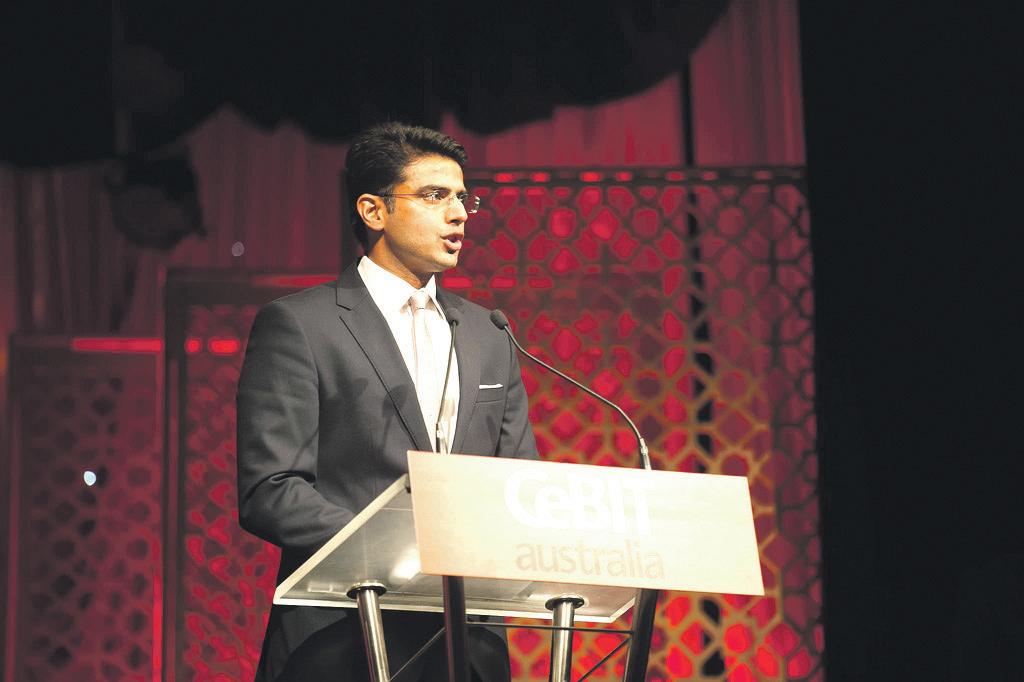
Mr Som Mittal, President of NASSCOM said, “It is
Mr Anu Agrawal, Chairman of NASSCOM Australia said, “We are privileged to recognise the high level of innovation from students of Australia’s universities, which are and ought to be a breeding ground of innovation in any country. The content and quality of the presentations to our judges was excellent and demonstrated many fine examples of originality.”
The Awards, which will be presented annually, aim to recognise and award innovation in Australia’s universities and are a great opportunity to showcase
innovative solutions to the rest of the world. The awards were managed by Consensus, with Fragomen, Wipro and Advantage Wollongong coming on board as sponsors.
The award ceremony was a part of the ongoing 3-day mega business event CeBIT 2012 in Sydney’s Darling Harbour, which had a high level of participation overall, including a 70+ highprofile delegation from India.

NASSCOM Australia is the Australian chapter of NASSCOM. Its members have currently invested upwards of $100M to
set up more than 20 development centres in Australia and currently employ more than 7000 people in Australia. They have strong links with many universities in Australia to recruit students for global projects, run student internships programs and have established scholarships.
In a follow up event, the outgoing Consul General of India for Sydney, Mr Amit Dasgupta recently held a felicitation ceremony for all the winners and participants of the NASSCOM Innovation Student Awards recently. The event was well-



 By KOMAL UTSAV JAGAD
By KOMAL UTSAV JAGAD

Thousands took to the streets on May 26 as part of the Blacktown City Festival - Streets
Alive and Parade Day, a fitting conclusion to the week-long event held from May 19-26. This event is the biggest of the year for the city that is organised by the Blacktown City Council, delivering a diverse range of events and performances for residents and visitors. It is now a huge platform for enhancing the image of Australia as a multicultural nation.
Said Mayor of Blacktown City, Councillor Alan Pendleton, “The Blacktown City Festival is one of the largest community celebrations in Western Sydney. It draws amazing crowds.” Over 70,000 people from 50 different countries participated in the kilometre long parade which, as promised, was a remarkably spectacular display of colours, cultures and excitement with clowns, floats and marching bands.
Featuring over 300 street stalls, 7 performance stages, amusement rides, gourmet food stalls, electrifying displays and heaps of other attractions, the parade was an extraordinary way to end the BCF. Speaking of colours, bands, food stalls, parade… how can us Indians stay aloof from this kind of an event? It’s more like a wedding baraat, essentially without the ghodi and the dulha, but with the parade, band, food and masti!
The Panjabi Sangeet Centre (PSC) jointly with the Australian Sikh Association under coordination from Mr Harkirat
Sandhar and Dr Surinder Singh, presented a slice of Indian culture to represent the country amidst various other cultures. Everyone rallied on the streets of Blacktown for the parade which started at the Warrick Lane Car Park at 11am sharp.
“Over 200 Indians joined in with other cultures, driving home the message that the parade was intended to strengthen bonds between Indians and other nations, especially Australia,” said Mr Sandhar, President of PSC. People heartily waved their arms to the enticing tunes of the dhol, while Punjabi bhangra and gidha


performed with colourful pots and sticks as props made a vivid picture in the parade.
Folk and fusion bhangra performance by Raju from Rooh Punjab Di brought to Blacktown the traditional colours of Punjab. Devinder Singh Dharia, Founder and Director of PSC presented a Punjabi folk song and Sukhman Kaur presented a beautiful dance number.
All the attendees had the opportunity to shop for knickknacks, handcrafted jewellery, showbags and taste a world of flavours from many different food stalls. Indian gourmet food
included our very own chaat, south Indian and Punjabi dishes like samosa, dahi bhalla, dosa, masala chai, chola bhatura, bhel puri and biryani. Other food stalls that were popular sold an array of sushi, wraps, canapés, burgers, pizza, among others.
The limelight of the event was a performance from very special guests Josh, Nate and Andi from Young Mens Society, one of the top 8 performers from the X Factor 2011. Said Nate Tamati, “We’re excited to perform here!”, and the audience enthusiastically shared in their excitement. They performed their debut single
We Own the Night, and as fans demanded the usual ritual of getting a scribble on parchment, they happily obliged.
The Parade Day has set an example with its futuristic outlook of global union by welcoming all cultures to come together and personify unity in diversity. It has helped push Australia a step ahead, enhancing the theme of multiculturalism in this wonderful nation through an array of bright, colourful and beautiful entertainment. Kudos to the Blacktown City Council for a wonderful effort and spectacular show!







Cementing closer ties between NSW, India and China is high on the list of priorities for any government: the NSW Premier Barry O’Farrell, with the help of NSW Multicultural Business Advisory Panel (MBAP) has achieved just that. He recently announced that a charity cricket tournament to begin later this year between NSW and India, has attracted $200,000 from China Southern Airlines.

Mr O’Farrell revealed that the NSW Maharashtra Cricket Cup to be held in Western Sydney in October will be sponsored by China Southern Airlines to the value of $200,000. The tournament between the Mumbai Cricket Association and Cricket NSW, announced during the Premier’s trade mission to India in November last year, will have the proceeds of the biennial game between a NSW XI and a Maharashtra XI, directed to charity.
“Funds raised during the inaugural China Southern Airlines
ties between our two states. With the support of China Southern, former Australian cricket captain Mark Taylor AO as Ambassador,
and the commitment of the two cricket associations, I am confident the inaugural event will be a success”.
Mr O’Farrell also acknowledged the role played by MBAP chairman Nihal Gupta who met both China Southern Airlines and the Mumbai Cricket Association during the trade missions last year and has successfully brought the two parties together.
According to official sources, the term of the sponsorship is one year and though the terms of the arrangement are commercial in-confidence, there will be some travel with the airline flying the Maharashatra XI to Australia for the inaugural match. “The China Southern Airlines Tournament is the airline’s first foray into Australian sport,” China Southern Regional General Manager Australia/ New Zealand Henry He said, adding that his company will provide a combination of in-kind benefits such as free air travel and cash.
Pawan Luthra
Just some of our many satisfied clients:
• “I got my 457 work-permit (from student visa) within 4 weeks. Mr. Ramneek done his work very accurately, on time, without any failure & provides perfect guidance. I am very happy with his work & very thankful to him” - Chirag Patel, Kew, Victoria.
• “I was able to negotiate through the complicated process & retain a baker full time in my business. For 457 working visas, Mr. Ramneek Madahar’s services are highly recommended. Definitely a 5 star service.” - Harry, Bakery Owner, Oatley, NSW
• “I was finally able to receive confident & correct advice in relation to my situation from Mr. Ramneek Madahar.” - G. Bastola, For SC457 Visa, Homebush, NSW
• “Thank you for your timely assistance with our restaurant sponsorship and 457 visa grant.” CH Patel & DC Patel, Restaurant Owners, Camberwell, Victoria
• “Ramneek Sir has made our 457 visa 100% successful. Thank you forever.”
- Shruti Shah, Merrylands, NSW
• “I was a student in Australia. Mr. Ramneek helped me for a 457 visa.”
- Chaudhari Prakash, Ashfield, NSW
• “I was on a Bridging visa for my SC885 visa application on 110 points. Mr. Ramneek made my 457 visa possible.” - C. Patel, Merrylands, NSW
• “For any complex cases, to anyone who needs help in immigration... don’t worry you are in safe hands.” - A.H., 457 Work Visa, Cronulla, NSW
“I sincerely recommend Mr. Ramneek’s services for immigration.”
- K.K., Central Coast, NSW
• “Mr Ramneek Madahar, thank you very much for our PR. Your efforts are appreciated & thanks for looking after my case
– D. Patel, Business Skills, Melbourne, Victoria
• “I am thankful to Ramneek for my permanent settlement in Australia.”
- Vikas, GSM, Parramatta, NSW
• “I applied for Regional - SC119 visa under the DRC on 15/11/2011, the visa was granted on 09/02/2012. Mr. Madahar has handled my application very well.”
- Vijaya, Bourke, NSW
• “Thank you Mr. Ramneek for my ENS PR under exceptional circumstances.”
- S. Kumar, Croydon, NSW
• “Thank you for your support & help towards my ENS PR.” – S. N., Ingleburn, NSW.
• “I am very thankful to Ramneek Sir for his help & support for my ENS residency. I had no hopes left & was planning to go back to India with my family.”
- K. Shah, South Strathfield, NSW
For appointments, please call 02-9745 3106 or 0412 764 600 or email: enquiries@tglt.com.au
(5 min.
Tree
Course Admissions (Australia wide), Student Visas, Work/Sponsorship Visas (457s, RSMS, ENS), Partner Visa, Family Visa, Tribunal Appeals & Waivers, General Skilled Migration.






Indian Restaurant / Takeaway
Established and reputed for over 20 years. Near Sydney CBD.
Completely renovated recently. Selling at fitout cost.
NOT SUITABLE FOR INVESTORS.
Suits family with high equity in own house. No experience in cooking required. Full training provided.
Once in a lifetime oppurtunity for the right family!
Price: $590,000 + stock
Apply via email: recklaw2012@gmail.com
or call Mohinder 0409 19 2035
Please call between 11am - 3pm Mon - Fri
Property ownership necessary

For all your Migration and Australian Visa related queries call now at0433 986 780
Our services include:
• Advice on Migration pathways
i) General Skilled Migration
ii) Student Visas
iii) State Sponsored Visas
i v) Business Migration
v) Partner and Family Migration
• Visa assessment (Eligibility assessment)
• Complete preparation of visa application
• Guidance on study options and facilitate Student Visa procedures
• Review procedures in Australia
CONTACT:
Sonal Agrawal
MARN- 1169617
Level 2, Suite 8A, 48 Macquarie Street
Parramatta, Australia 2150
MOB 0433 986 780 PH 02 8677 5161
Email: sonalagrawal0@gmail.com

Syed Mohiuddin 0421119628 syed@completemigrationservices.com.au contactus@completemigrationservices.com.au
For quick visa assessment ll the online visa assessment form on www.completemigrationservices.com.au
We help you achieve a better life and pursue your dreams.
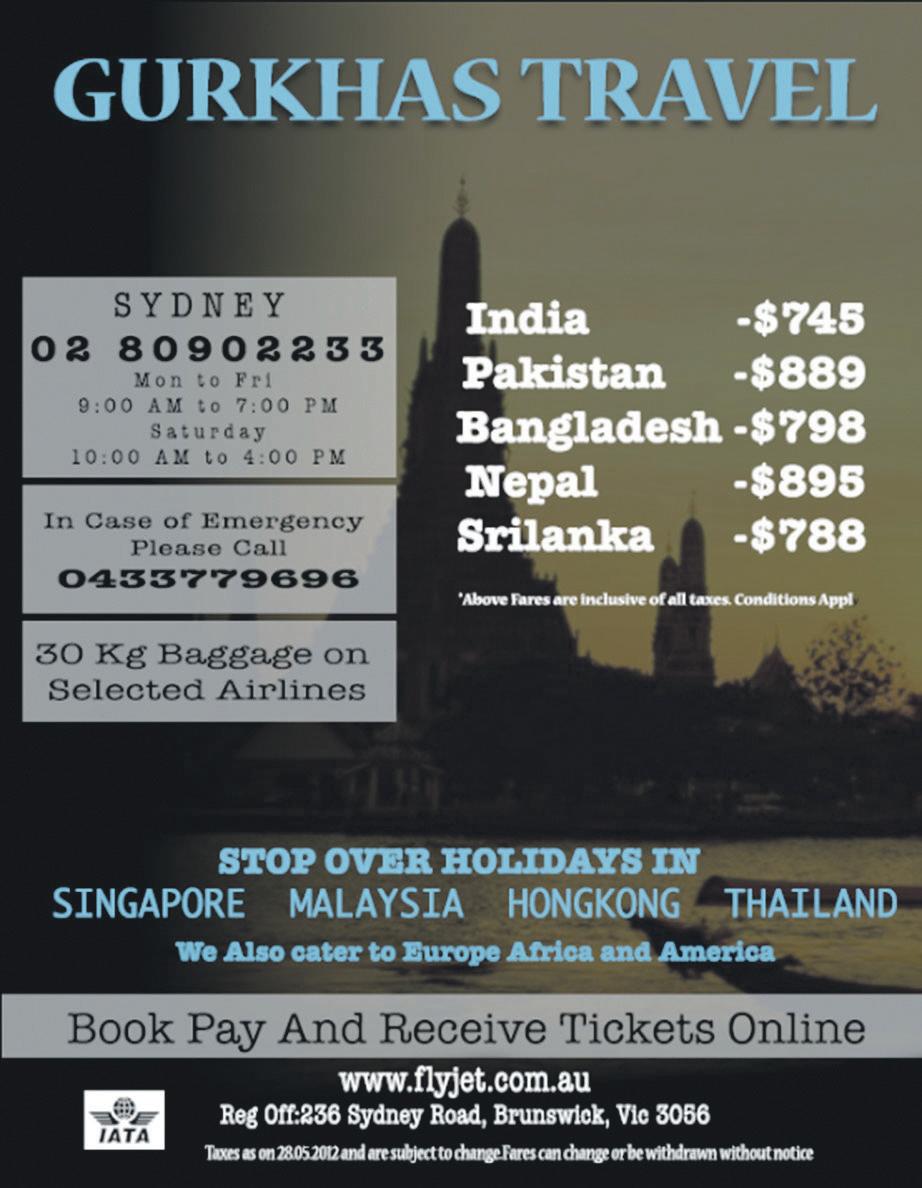
In Rajya Sabha, Tendulkar to help other sports too Cricket legend Sachin Tendulkar, who took oath as a Rajya Sabha member recently, vowed to help other sports as well and said he would be liked to remembered as one who contributed to the country and not just cricket statistics.
Speaking after taking oath as a nominated member, Tendulkar told reporters that he might face obstacles but hoped to carry on with help from fellow parliamentarians.
He and his wife Anjali met Minister of State for Parliamentary Affairs Rajeev Shukla in the chamber of Rajya Sabha chairman Hamid Ansari.
“In the last 22 years of my international career, cricket has given me so much. I also wanted to give something back to cricket in the latter half of my life,” Tendulkar said.
“Today with the nomination, I am in a better position not only to help cricket but also other sports. It means a lot to me.
“I believe there will be a few obstacles along the way, and I will need (help) from my fellow parliamentarians, the administrators, media and our countrymen. Together we can make a lot of changes,” he added.
The batting maestro said he would like to be remembered as somebody who contributed to all sports in India “rather than just cricket statistics. That would be fantastic”.
Asked if he will find enough time for parliament, Tendulkar made it clear that his first priority would be cricket.
“I did not go to anyone asking to be a Rajya Sabha member. It’s an honour and I accept that with respect.
“But I am here because of my cricket.
I can’t take my focus away from cricket because that is where it all started for me.”
Tendulkar also said that he will focus on his game, and as and when he gets time he would contribute not just for cricket but for other sports as well.
“At this moment my focus will be on cricket, and as and when, there is time in between, I will look at other things, and see how I can help and bring in whatever changes.... not only cricket but all other sports.”
The government should not blame the eurozone crisis for the present economic slowdown as it is largely due to the domestic factors like excessive monetary tightening, lack of reforms and delay in project clearances, a top industry lobby said in New Delhi recently.
“The current economic problems are largely a result of domestic factors like excessive monetary tightening, delays and uncertainty over key economic legislations,” said R.V. Kanoria, president of Federation of Indian Chambers of Commerce and Industry (FICCI).
Kanoria said project delays on account of factors, including stalled environmental clearances, problems in land acquisition, prolonged pause in reforms and an atmosphere of unwillingness in decisionmaking in bureaucracy, have also led to the slowdown in industrial growth.
As per data released by the Central Statistics Office, India’s economic growth slumped to a nine-year low of 5.3 percent in
the fourth quarter of fiscal 2011-12.
The country’s gross domestic product expanded by 6.5 percent in 2011-12, which is even lower than the 6.7 percent level achieved during the global financial crisis of 2008-09.
Top economic policy makers, including Finance Minister Pranab Mukherjee, have blamed the eurozone crisis for the current economic woes.
However, Kanoria said that the current economic slowdown was largely due to domestic factors and urged the government and the opposition parties to act together to overcome the crisis.
“There has to be clear recognition on the part of ruling and opposition parties that we are in crisis situation and all parties need to stand united and strengthen the hands of policy makers to take bold decisions and act decisively,” Kanoria said at a media interaction in the capital.
FICCI president suggested a 12-point action programme to address the present economic crisis situation.
To bring fiscal discipline, the industry lobby suggested that the “government should eschew the temptations of a premature welfare state and announce an immediate moratorium on any additional expenses on doles”.
FICCI called for 200 basis points or two percent cut in interest rates and 100 basis points or one percent cut in cash reserve ratio by the central bank to ease liquidity situation.
Other suggestions include expediting implementation of the goods and services tax (GST), fiscal stimulus for investments through accelerated depreciation, investment allowance, scrapping minimum alternate tax (MAT) for infrastructure, foreign direct investment (FDI) policy reforms in areas like civil aviation, multi-brand retail, decontrolling diesel prices, and reforms in mining and coal sector by fostering greater competition.
FICCI also called for strengthening framework for raising funds for infrastructure, productivity increase and agriculture marketing reforms for food security, fast track implementation of critical polices and projects, and addressing the issue of repatriation of black money to immediately mitigate balance of payment situation.
Kashmiris want autonomy, better economic opportunities and removal of “overbearing presence of armed forces from their state”, a gathering of Kashmiri youth, activists and separatists said during an interaction in Srinagar with young people from New Delhi.
Setting the stage for the discussion, students from Kashmir University and young professionals asked for the removal of the armed forces and “a commitment for dialogue” to secure their democratic rights.
“Laws such as the Armed Forces Special Powers Act (AFSPA) need to go. The militarised zone is meant to suppress Kashmiri people, not to secure the borders,” said Saba Khan, a human rights activist.

“We would like to see a clear road map towards demilitarisation and ensuring basic democratic rights for the youth of Kashmir,” she said.
“What security forces are securing is my sense of insecurity,” she added.
Also present at the discussion was Jammu and Kashmir Liberation Front leader Yasin
Malik. He said the present generation of Kashmiris were conflict-borne children and were frustrated with the government. “And apart from political problem, it is a human problem.”
Criticising the killing of Kashmiri youth during the 2010 protests, Malik said: “The people’s movement turned into a non-violent movement in 2008 but even that has not been appreciated.”
“In the land of Mahatma, I could not find the soul of Gandhi,” he said.
The interaction was organised by the Centre for Policy Analysis, an organisation working in Kashmir. With AFSPA providing security forces immunity from prosecution, the participants spoke about incidents where the soldiers misused their immunity and harassed Kashmiri people.
“The lull in the valley you see at the moment is not peace,” said participant Faisal Qadri.
“Here, we are governed by a man who does not necessarily hold a matriculation certificate but has a gun,” he said.
He also said that youngsters who took part in stone pelting in 2010 were not drug addicts or paid by politicians.
“They were not terrorists. They were just suppressed youth who wanted to have the freedom to fulfill their aspirations.”
“Kashmiris have political aspirations as well as economic grievances. They have been persecuted both by New Delhi and our leaders,” said participant Junaid Matoo.
“Kashmiris want freedom to live a life of dignity which New Delhi has denied us. At present, the right to dissent, which should be our democratic right, is denied to us and our leaders have failed to institutionalise it,” he said.
Hamida Naeem, a teacher from Kashmir University, said that the consensus in the valley was not to be a part of India. Others too gave similar views.
“It is sad that the problems of Kashmir are never highlighted in the country’s media,” said editor of newspaper Rising Kashmir Shujat Bukhari.
Later, on queries of the Kashmiri participants, the visitors, who were students of Jawaharlal Nehru University, Delhi University and Jamia Millia Islamia and young professionals, said the focus should be on dialogue and creating common ground.
“Dialogue is very important. Conflict can never be an answer to political questions,” said lawyer Bajinder Singh.
The fight of other oppressed people across the country against social and economic inequalities can be a common ground for our friends from Kashmir,” said Jawaharlal Nehru University student Arjun.
“We need to create joint action and to put public pressure on the country’s political powers to address the violations of human rights and democratic rights in the valley,” he said.
The visitors agreed on the formation of a youth coordination committee to address issues such as demilitarisation, withdrawal of AFSPA, investigation into fake encounters, resumption of dialogue, restoration of the right to dissent, re-compensation for forced labour and environmental exploitation.
It has been a tough battle for Faiza Nisar Ali who helped steer the entry of girls into the erstwhile male bastion of the historic AngloArabic School.
Muslim women created history when the school admitted girls for the first time in its over 300-year-old existence.
Faiza’s fight began in March when she was appointed to prepare a feasibility report on why Muslim boys and girls should study under the same roof.
She had to contend with numerous pitfalls along the way, including frantic phone calls from community hardliners trying to dissuade her, being blamed for scripting something “un-Islamic”, countless sleepless nights and also the trauma of a miscarriage.
“After months of research, consultations with educationists, psychologists and parents, I concluded in my report that co-education among Muslims would result in greater progress and help them in the later stages of life,” said Faiza, who is in her thirties and is the business studies teacher at the same school for over six years.
She recounted the events with moist eyes.
“After the report was done, the staff became very resistant. The teachers went against me and I was held liable for being un-Islamic,” she said.
The report spoke on how co-education could boost academic performance of both the sexes, a feasibility into the structure of the Anglo-Arabic school and its importance and it also highlighted that Muslim parents wanted their girls to go to a co-ed institution.
Despite facing internal resistance from the predominantly male school staff, the managing committee of the school in a meeting on March 26 decided to open its doors to girls.

The decision was considered historic for the school, located at Ajmeri Gate, in the old quarters of Delhi.
However, the landmark decision did not end Faiza’s agony.
While her family was supportive about the step she had taken, the mental pressure due to the angry reactions brought her to hospital.
Then eight weeks pregnant, Faiza went through a miscarriage. But she was gutsy enough to pursue her dream.
“I had this invisible pressure about how to face colleagues in the school. I had gone through a lot, but I did not want to leave it in the middle,” the mother of a five-year old admits, adding that her “mother had even suggested her to distance herself from all the activities”.
Her cause got a stronger voice when more Muslim women joined the cause. A
Alvi, filed a petition in the Delhi High Court. On May 24, the court backed their cause. The school management swung into action and has so far admitted over 30 girls in Classes 6 to 11.
For many Muslim girls studying in nearby girls’ government schools, the move is a dream come true as they can switch to the Anglo-Arabic School that has produced the likes of Liaqat Ali Khan, the first prime minister of Pakistan, Sir Syed Ahmad Khan, founder of Aligarh Muslim University, J.N. Dixit, former national security adviser and foreign secretary.
Burqa-clad petite Darakshna Fatima, 17, beams with joy for having made it to the school.
“I lost my father 6 years back, since then my mother has been the pillar of strength for me,” said Darakshna, who aspires to become a chartered accountant.
The Class 11 student added, “Our relatives had reservations, but I am proud that my mother fought for my education.”
Darakshna’s sister Gulafshan has also secured admission to the school that started off as Madrasa Ghaziuddin around 1692. While the school management says the facilities for girls, such as girls’ common room and separate toilets, will be strengthened, the first target for the coming 32 girls is ‘equality’.
Jamia Millia Islamia Vice Chancellor Najeeb Jung, president of Delhi Education Society, under the aegis of which the school runs, recently felicitated the first batch of 15 girl students who were admitted to the Anglo-Arabic School.
“This is the girls’ first step towards better schooling. The change will come gradually. .. Modern education has started arriving for girls from the community,” Jung said.
“We are expecting more girl students in the coming days. There will be a female teacher to attend to the special needs of girls and we plan to recruit more female staff,” said Azra Razzak at Jamia Millia Islamia, who is also secretary, Delhi Education Society.
However, Faiza says the fight is not over yet. Though girls have been admitted, the resistance among many staff members remains.
“Let’s hope there is an attitudinal shift and changes begin to happen,” Faiza said.
She had faced resistance when she was selected among three women teachers to join the 80-member strong male staff at Anglo-Arabic School. She remembers facing
“Initially it was very suffocating, gradually came better understanding,” Faiza recounted, and hopes attitudes will change for the girl students too.
Anticipating hardships in finding skilled workers onshore, the largest beef producer of the continent, Australia Agriculture Co (AAco), may recruit hundreds of Indian workers for its new abattoir in the country’s north.
“India will be key, but of course we have a relationship with IFFCO which kills about 3.5 million buffaloes a year. So we have a bit of access to the skills there,” AAco chief executive David Farley told The Australian Financial Review
The statement is taken as an indication that there would be some recruitment from Malaysia too as IFFCO, the major shareholder of AAco, is based there.
The company is expecting trade unions to create hassles for the new project planned to be established at Darwin in Northern Territory.
“If we go into this project with fear of unions and industrial problems, then I shouldn’t be starting this project,” Farley said.
“We want to run a safe, fair and equitable plant that offers long-term employment opportunities for people. Therefore we need a productive workforce. If we go into this project with that philosophy, we will be there for a long time,” Farley said.
AAco has been involved in stoushes with trade unions in the past. Its chairman, Donald McGauchie, also played a significant role in the national waterfront dispute two decades ago.
The trade unions have already started expressing concerns about the Darwin abattoir project and the AAco plans to bring in workers from India.
“Obviously we want businesses to open but there has got to be a process in place whereby the first step is not to go overseas,” Unions NT president Heinz Schmitt said, commenting on AAco’s plans about the Indian workers.
The new meat processing facility would need 260 workers to operate the A$80 million plant. Most beef products would be exported to the US, South Korea and Indonesia.
Besides India, AAco may also get workers
shareholder IFFCO is based) and Indonesia. AAco has previous experience in flying in workers directly from overseas.
“We’ve had great experience recently in running our feedlots with staff out of the Philippines. In Darwin, we tend to run a programme bringing in Indonesian slaughtermen on a training programme.
“Through one of AAco’s major shareholders, (we) have access to good meatworks staff out of India,” Farley had told shareholders at a conference earlier.
“We can fly staff direct into Darwin from Mumbai or Delhi for $618,” he said.
“We’re looking at skilling, from an international as well as a domestic perspective,” he had added.
Although most of the developed countries are experiencing recession, Australian employers are struggling to find skilled workers due to a China- and India- driven resources boom.
As most Australian and foreign skilled workers are making a beeline to the mining sector, manufacturers are facing a tough time finding workers ready to work on comparative low wages.
The mining boom has created an unlikely skills shortage in Australia, thus playing a significant role in the closure of many large manufacturing and servicing plants.
If AAco gets a nod from the Australian Immigration Department, the Indian workers are likely to be imported on subclass 457 visas.
IANS
Healthmax are the sole Australian agents of an international cookware company enjoying major success overseas.
Voted ‘World’s Best Cookware’ at About.com Readers Choice Awards 2011 & 2012, these Þrst class products are presented and sold by in-home demonstration in 40+ countries. Several million sets have been sold since 1946. We are seeking resourceful, motivated individuals, preferably with (direct) sales experience, to market the product in the Indian community.
Training, equipment and ongoing support will be provided. A six Þgure performance based income is achievable for the right applicants.
We invite individuals with suitable ability and experience to forward their resume’ to: ben@healthmax.com.au or phone 0432 250 400

As the sun goes down and the temperature plummets, the iconic Sydney skyline lights up with an inspired display of sheer creative genius, creating an interactive nocturnal playground.
During the waning weeks of May, thousands turn up at various foreshore destinations for a sumptuous spread of ideas and creativity. In its fourth year, Vivid Sydney, the hugely popular son et lumiere show, is not only ‘the biggest ideas festival in the southern hemisphere’, but also voted among top ten worldwide.

The 2012 edition which concludes on June 11, is particularly special to visitors of South Asian backgrounds. An Indian Australian has been recognised for the first time, for his significant contribution to the winter festival.
Akil Lau, a talented architect and acoustics engineer who works for construction services company Aurecon, has created the sound effects for the Water Droplet, a 1.5 tonne installation at Campbell Cove.

“Very rarely do we get a chance to represent our country of birth on such a large scale. Getting to do that in such a beautiful city, which is a favourite with many Indians, was priceless,” Lau told Indian Link. “Seeing the reaction of visitors and overhearing an Indian couple scream, ‘Ispe
water theme fitted in well with the waterscape that the festival walk weaves its way around, and the incorporation of sound had appeal for the judges.”
The creative team included electrical engineers Ying Ching Hui, Zac Dalleh and Brendan Fernandes, ICT consultant Charlee Dare, specialist façade engineer Ramy Sorial and REVIT modeller Barry Fauvel, besides Lau.
Lau, who holds a double Masters in Industrial Design and Audio & Acoustics from New Delhi and Sydney respectively, has composed the audio piece dubbed Liquid Tension, which was incorporated into the sculpture.
“Bringing each installation to life is possible only as a team effort from a wide variety of professionals like lighting professionals, sound engineers, designers, architects, music composers, dance directors, theatre artists, etc. I was proud to be a part of such a talented team and will remember this as an event which gave my talents a platform, but more importantly allowed me to represent India in such a global event,” stated Lau.
Interestingly, the young Punjabi’s involvement in this prestigious project was the outcome of a chance lunchtime discussion. Noting his creative inputs, he was roped into the project.
“Water Droplet is an experience for the two major senses, visual and aural. The blue light, known to calm the senses, aids the intent of the sound design. Since ages, the sound of water has been known to create a calming effect on the human mind. The combined effect creates a state



India ka naam hai!’, was the best compliment I ever received”.
“It is a thing of utmost pride for us, and we would love to share this moment with every proud Indian in Sydney and the rest of Australia,” Mahi Lau, Akil’s wife who is also an architect, added excitedly.
The project which was six months in the making, is the brainchild of Aurecon’s lighting designer Destiny Paris.
An Aurecon media release noted that the Water Droplet “was a desirable contender, as the

of mind which can be likened to a trance, when experienced at the optimum surroundings,” explained Lau.
“The storyline behind the 5-7 min long audio composition is that of a single water drop sound which starts off with random thunder. The water drop slowly catches momentum thus producing a rhythmic beat. Slowly the beats from the falling water drops, turn into a musical composition. After achieving a crescendo one can hear the dissolution of the composition
back into the sound of flowing water,” he added.

“The story symbolically depicts the ever-familiar human life pattern which starts randomly, slowly gets into a rhythm and finally dissolves into eternity, becoming one with the universe,” he concluded.
Elaborating on the technical aspects Lau indicated that the five chimes of different lengths hanging from the middle of the installation were fitted with sensors which were triggered with slight movement of the chimes. Each trigger on the chime was linked to a separate chime sound. 5 different chimes sounds were created using the sound of a single chime. This was done, simply by changing its pitch (frequency), based on the pentatonic scale (major). Pentatonic scale is a musical scale with five notes per octave in contrast to a heptatonic (seven) scale.
The loudspeakers are connected to a Digital Signal Processor (DSP) and the programming in the DSP was done so that the sound of chimes created an illusion of large space and the sound moving around the space. There were a few other techniques inserted in the DSP, which allowed the background track to reduce (ducking) in levels when the chimes were struck.
Interestingly, all the audio equipment has been stored in a cabinet away from the main structure except for the 3 speakers and an active subwoofer, which is placed inside the seat with holes on the front surface to let the sound out.
Lau believes that a solitary space with minimal encumbrances would have been ideal to bring out the best effects, visually and aurally. Though this might mean a visit to the installation late into the

night, he added.
Being part of such a largescale event has been an enriching experience for this music fanatic.
“I think Vivid Sydney brings out the best in the city’s landmarks. With many buildings along the harbour front participating in the festival this time, the look of the city from the Opera House podium is ethereal. It is a moment of truth for the city, which has all the vivid colours in all the residents’ day-to-day lives,” he said.




“Music has been an integral part of Akil’s growing years. While studying Architecture his design thesis was based on a School of Music – a school with the optimum spaces creating an environment conducive to learning and enjoying music. Since then, he has had an eventful journey through all aspects of music and sound,” recalled Mahi, who also shares his passion for music (albeit in a different genre).
Akil Lau has successfully blended visual design with acoustics for a perfect amalgam. He has worked on several landmark projects in Sydney including Sheraton Four Points and Telstra.
The story symbolically depicts the everfamiliar human life pattern which starts randomly, slowly gets into a rhythm and finally dissolves into eternity, becoming one with the universe
Akil Lau
Seeing the reaction of visitors and overhearing an Indian couple scream, ‘Ispe India ka naam hai!’, was the best compliment I ever received Akil Lau
His surname inspired a key character in the hit Bollywood film Kahaani Now writer Amitabha Bagchi has knit a plot about Indian bureaucracy, corruption and redemption in his new work, The Householder.

Bagchi, who earlier penned the bestselling novel Above Average, notes: “I had started writing the book long before corruption had become public. Halfway through the book, the Niira Radia tapes came about and the 2G scam surfaced.”
Bagchi, who teaches at the Indian Institute of Technology (IIT) Delhi, was inspired by noted Hindi writer Shrilal Shukla’s novels and literary critiques.

“I never had to deal with bureaucracy and I could not understand how the bureaucratic system works. The figure of a lower bureaucrat became important to me. Shrilal Shukla’s writing and my encounters with lower bureaucrats came together to become the genesis of this book,” Bagchi said.
The book exposes the government underdog - the lowly yet egoistic babu, who takes the beating on behalf of his bosses
for reasons beyond his doing. And survives the blows.
“I don’t think what ails the system is the lower bureaucracy. The lower bureaucracy is the symptom. In Shrilal Shukla’s novels, his heroes like Amrit Lal Nagar and Bhagwati Charan Varma talk about societies which are fundamentally corrupt, where people are exploited by whoever has a little bit of leverage over another,” Bagchi said.
He is the man who inspired Advaita Kala, the scriptwriter of Kahaani, to name a character in the film with the same surname.
“Advaita told me that she knew Vidya Balan would be playing the lead and Bagchi was the obvious choice.”
“There is a funny story about it which Advaita has not told anyone. When I met her, she told me that Bengali men make the best husbands. The surname was on the top of her head when she was creating Arnab Bagchi, Vidya’s husband,” Bagchi said.
In his new book The Householder (Harper Collins-India), Bagchi’s protagonist is a very familiar Naresh Kumar, personal assistant to R.K. Asthana, an IAS officer.
Naresh is a householder with a
wife, son and daughter. He is an indispensable cog in the wheel of bureaucratic corruption because a share of the largesse that flows through Asthana’s door trickles down to Naresh.
Like every “householder” on the babu’s payroll, Naresh is besieged by filial misfortune. His married daughter has trouble conceiving a child and his son’s call centre job is shady. To make matters worse, Pinki Kaur, an attractive widowed mother at work, is a distraction.
He is suspended from his job for a botched deal. But as the householder, Naresh has to fend for his family even when out of job. Redemption arrives at the end of the novel when the inquiry commission clears Naresh - the fall guy - and returns him the job in the ministry.
The writer pointed out that in The Householder, his hero was neither a Niira Radia, nor an A. Raja nor a Kanimozhi. “I am not talking about the high-fliers and neither about the wretched of the earth. I am talking about people who are in the middle and hold some power,” Bagchi said.
Bagchi’s father was in the postal service and had “many
beating on behalf of his bosses for reasons beyond his doing. And survives the blows.
subordinates”.
“There was a certain kind of relationship between them and my father. The subordinates instinctively know men in power by the body language,” Bagchi said, enumerating Naresh’s character.
Another aspect that Bagchi wanted to probe in the book was
“the concept of masculinity”. “I wanted to see how men are made and what are the pressures they face all over the world when they provide for their families. I think to provide and care for the family is a fundamental emotional requirement of a man,” Bagchi said. Madhusree Chaterjee
Humour has been the golden lining of India’s realpolitik for as long as one can remember. The early kings hired jesters; Mughal emperor Akbar had Birbal and, in the 19th century, quick-witted Indian writers picked up from the British bible of humour, Punch, to laugh like the white “babus”.
By the end of the 19th century, at least 70 Indian-style Punchlike papers and magazines had appeared in over a dozen cities of the country.
“Humour unfortunately is now on the decline in public life. The composition of political clans has changed so dramatically that their appreciation for humour is diminishing. Public life has become very combative and politics competitive. The ability to laugh is becoming more of a rarity,” historian and anthologist Mushirul Hasan, the director of the National Archives of India, says.
Hasan’s new humour compendium, Wit and Wisdom: Pickings from the Parsee Punch (Niyogi Books) published last month, has reproduced some of the best caricatures from the illustrated Parsee comic weekly

paper published for over seven decades from 1854.
The cartoons mirror the social and political situation of Bombay and the western provinces of the country in the light of world events
There are also academic accounts of the history of the Parsee community in India and how politics, religion, reforms, identity and foreign affairs affected their lives.
The Parsee Punch, like the London Punch, contained 20-36 pages of funny illustrations. The weekly’s name was later changed to Hindi Punch for a more panIndian identity and continued to be published till 1930.
“You can’t conceive a human society without humour. Modern India had several great humorists like Mahatma Gandhi, Sarojini Naidu and Jawaharlal Nehru.
Shankar was everybody’s favourite and with Laxman, the common man became a symbol. There was a lot of homour in Urdu writing before and after Independence,” Hasan said.
The cartoons have a nationalist colour. A late 19th century Parsee Punch illustration, “A Loving Pair”, makes a political comments about
a cross-cultural love.
It reads thus: Fergusson (to a native sari-clad lady, whom he hugs): “Yes, my dear, I shall always try to make you happy!”
Miss Poona Bai: “I am so happy, so joyful for your kind and sincere attention towards me, my dear Fergusson, that I am unable to express my feelings in words...”
(Sir James Fergusson had made an important concession for establishing a native girls’ high school at Poona.)
“The remarkable thing is that even though the Indian Punch writers were critical of the ruling British government and its policies, the British never proscribed any of the issues. There was a certain level of acceptance of the humour,” Hasan said.
The Indian avatars of Punch brought about an acknowledgement by the erstwhile British rulers that “Indians had a sense of humour”, Hasan said.
“They realised that humour will be appreciated by the educated elites. They would read, laugh and forget about it,” Hasan said.
The Parsee Punch is the second in the series of Punch anthology by Hasan.
The first volume consisted of
pickings from the Awadh Punch, published from Lucknow from January 1877 to 1936.
“The Awadh Punch, edited and published by Munshi Sajjad Husain, was a household name hosting writers like Akbar Allahabadi, Ratan Nath Sarshar and Mirza Began,” Hasan said.
The character sketches in the magazine were described by critics as the “precursor of the modern
Indian short story”.
The Awadh anthology caricatured the Raj, defended Indian tradition and wrote political satires of early 20th century India with sketches of comical stereotypes such as “the patwari, chawkidar, revenue agent, honorary magistrate, the Englandreturned and the title-hunting associations of noisy zee-huzoors”.
Madhusree ChatterjeeThe cartoons mirror the social and political situation of Bombay and the western provinces of the country in the light of world events.
Mushirul Hasan

Specialised from Overseas (Shahnaz Herbal) and Australia


•
•

Around the 11th century, gypsies (gitanes) moved from India in arduous journeys in caravans. They migrated to the Middle East where they split into two bands, one going northwards to Eastern Europe. Hungarian gypsy music became famous through the Hungarian Gypsy Dances by Johannes Brahms. Another band went via Egypt to Morocco and thence to Spain, arriving in the 15th century. They suffered persecution in Europe along with other minorities such as Jews and Muslims, even as late as in the Second World War.
The late Mario Maya, director of the Centre for Flamenco Performance Studies who came from a renowned flamenco family of Granada said, “The subconscious influences which we brought with us date back to India because we emigrated from there centuries ago and although we’ve lived here for 500 years its still possible to see Hindu influences... the way we move our hands... the sounds we make.... the way our feet are deeply rooted in the earth.... always touching the ground like the Indian kathak....”
Official recognition for flamenco’s Indian origins has come from the Spanish Government which has decided to establish a flamenco institute in Jodhpur. Jodhpur lies in the original heartland of the gypsies.
Small dedicated dance groups keep kathak dancing, flamenco and their fusion alive. Ruchi Sanghi has taught dancing to

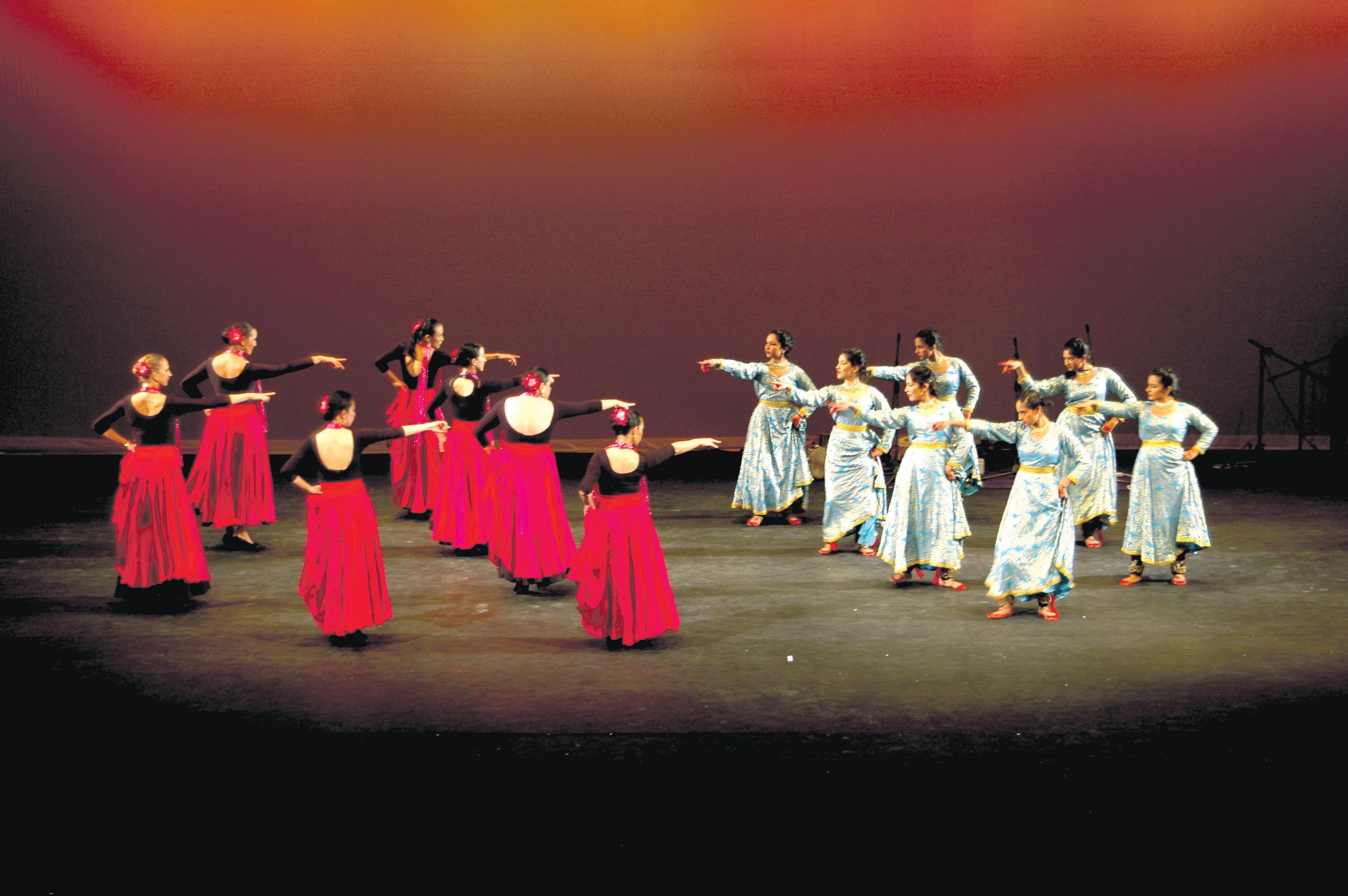
Australia awards show in 2004. Since then they have collaborated regularly for a number of shows.
The other instance where Spain and India meet in dance and music is in Goa, where during Portuguese rule, the missionaries were Spanish and amongst the things that they brought, besides food and dress, was their folk music which integrated with local rhythms and the Konkani language.
This writer, when visiting the Basque region in northern Spain in 1962, was astounded to hear the music sounding so Goan! The Jesuit missionaries, including the famous St. Francis Xavier, came from the Basque region.
The Franciscan missionaries were the other Spanish order which operated in Goa. Surprises continued in southern Spain where the music of the Baleares Islands (Mallorca and Menorca) had pieces which were identical to well-known Goan folk songs!
On returning to Goa, this connection was expounded by me in The Navhind Times. Spanish folksong recordings astounded connoisseurs of Goan folk music.
In recent years there has been a resurgence of Goan folk music, including adaptations by foreign bands visiting the state. Goan folk music can readily be converted to European-style classical music.
Goan folk music has been incorporated in numerous Bollywood songs because for many decades, Goan musicians had played for renowned music directors such as C Ramachandra, SD Burman, Shankar Jaikishen

pubs, singing the thrilling flamenco to the ecstatic rhythm of the Spanish guitar. They said that their people had come from India. This was not surprising by the way they moved their hands and created rhythm with their feet.
The gypsies of Spain became famous in the 19th century through Gustave Dore’s art. In a democratic Spain, flamenco has flourished through successful groups like the Gypsy Kings which have modernised and energised flamenco. The actress Brigitte Bardot popularised flamenco and this dance form has become the foremost of Spanish folk music and dance.
Flamenco singers are storytellers like the kathaks. Kathak is a northern Indian creation which flourished during the Moghul period. Kathak dancers entertained at royal courts resulting in the emergence of several gharanas or schools of the art form. The British despised the art as being a decadent practice by nautch girls.
Kathak needs to be promoted at the school level in groups like those run by Ruchi Sanghi and the flamenco teacher Sussana Menotte. Amongst the prominent shows which they organised were at the Fire Water festival at the Rocks in Sydney, at the Parramasala festival in Paramatta
and at the closing of the Goddess exhibition at the Art Gallery of NSW. Two major combined productions Namaste and Nine Flavours involved over 80 dancers and 8 musicians from both forms.
Such shows are spectacular for costumes, accompanying music and instrumental and feet rhythm. Ruchi Sanghi says, “I am truly passionate about bringing the lesser known kathak to the mainstream, as it is one of the most dynamic of theatre art forms. It has gained wide recognition in the US and UK, but we are yet to find that status for kathak in Australia.”
had pieces which


Once again, worriers across the globe garner their forces to find out whether this year will be the world’s last
By RITAM MITRA

Social media has been rampant over the last year or two, perpetuating the belief that the world is going to meet a catastrophic end this year. It could be simply put aside as a bit of fun and games due to conjecture – if it wasn’t for the fact that there have now been several cases of people committing suicide so as to avoid living through the “end of the world”.
As is typical of stealth marketing, the campaign for 2012 made no mention of the movie itself, and as a result, many unknowing viewers went as far as to contact astronomers in panic.
The recent hype around 2012 began primarily with the release of the 2009 blockbuster film 2012. The movie was advertised using stealth marketing, which, while hugely successful, involved websites and TV advertisements from the fictional “Institute for Human Continuity”, calling on people to prepare for the end of the world. As is typical of stealth marketing, the campaign for 2012 made no mention of the movie itself, and as a result, many unknowing viewers went as far as to contact astronomers in panic.


The belief in the 2012 myth, however, has its roots in the ancient Mayan “Long Count” calendar, upon which the film was based. The Mayans called the current period the “Great Cycle”, a cycle which will end on the winter solstice this year – the longest night of the year. For the Northern Hemisphere, this falls on December 21. It is not, as many believe, the end of the Mayan calendar – it is simply the end of one of its cycles.
This will supposedly be the trigger for a series of catastrophic and unpredictable events – cities being thrown into the sea as a result of a sudden shift in the Earth’s mantle and crust; a reversal of the magnetisation of our poles, and even a collision with the planet ‘Nibiru’. It must be noted that Nibiru has never been seen or proven to exist – believers refer to it as an invisible planet.
However, the ancient Mayans actually believed it was a cause for huge celebration to have reached the end of a whole cycle. In the same way modern civilisations celebrate the end of the year and the ushering in of a new one on December 31, so too did Mayans believe reaching the end of a cycle was a great occasion – it is just that this cycle began on August 11, 3114 BC.
civilisation that believed the year 2012 would be a momentous one. In 1998, Kalki Bhagavan, the Indian guru, spoke about the year 2012 as a ‘deadline’ bringing about the end of ‘Kali Yuga’, or the last of the four stages (the previous three being Satya Yuga, Treta Yuga and Dvapara Yuga) that the world goes through, according to early Hindu texts. Kali Yuga is said to be a phase of spiritual degeneration in humanity, and is referred to as the “Dark Age”. However, even here there is conjecture – some religious figures believe Kali Yuga is already over, while others believe it is yet to begin.
Scientists have been inundated with queries on the subject for the last five years. Since 2007, NASA’s ‘Ask an Astrobiologist’ public outreach website has been asked over 5000 questions on the subject, including some from people asking whether they should kill themselves, their children or their pets. Sales of underground blast shelters have grown rapidly since 2009, and the mayor of the Brazilian city São Francisco de Paula mobilised his city to prepare for the date by stocking up on food and water. Similarly, in Corguinho, another Brazilian city, a colony is supposedly being built for survivors of the apocalypse.
Closer to home, one in ten Australians believe the world will end this year, with believers said to fall into two camps – one camp is full of catastrophists, who believe comets will rain down on the Earth in a brutal end to humanity. However, it is interesting that the larger group of Australian believers see it as the end of the world “as we know it” – the ushering in of a new age of enlightenment, a shift in human consciousness and perhaps a more tolerant, peaceful society. The poll was commissioned by Reuters, and involved 16,000 people in 21 countries. 20% of the Chinese and Turkish respondents believed the world would end, but only 4% of Indonesian respondents agreed.
Closer to home, one in ten Australians believe the world will end this year, with believers said to fall into two camps – one camp is full of catastrophists, who believe comets will rain down on the Earth in a brutal end to humanity.
Humanity has been perennially fascinated by the concept of predictions and prophecies. There were 42 failed doomsday predictions regarding the year 2000 alone, and Harold Camping recently made headlines for his several failed predictions regarding the end of the world, through which he generated massive revenue for his radio station in California. The only thing that has been proven certain is that we are uncertain about the future.
It was not just the ancient Mayan
So what will happen on December 21, 2012? Probably not much!


The brutality of the Syrian regime has come to the forefront of global media in the past month, as Bashar al-Assad refuses to loosen his stranglehold on the country. Social media is awash with opinion and outrage over the blatant disregard for human life that has transpired in Syria, and it is purely misinformation that seems to be the primary defence for the Syrian government.
The background of the terror is crucial to establishing the violent context in which this regime operates. The Syrian uprising is part of the Arab Spring, a series of revolutionary protests and demonstrations that have engulfed the Arab world, beginning on 18 December 2010. Rulers have been forced from power in Tunisia, Egypt, Libya and Yemen, and the civil unrest in Syria is but one of several in the region.

Public demonstrations against the Assad regime began at the start of 2011, as protestors sought an end to nearly five decades of Ba’ath Party rule. The Syrian government reportedly deployed military units to quell the uprising, and it is clear that the problem merely escalated further. The situation now is dire. There have been up to 18,700 casualties, as well as tens of thousands of imprisoned protestors. Many of the victims were children.
Although the dangerous situation in Syria has been escalating for over a year now, affairs reached a climax late last month when on May 26, two days
before Kofi Annan, the UN-Arab League envoy to Syria flew in for scheduled peace talks with Assad. On this day 108 civilians were massacred in the town of Houla, through mainly execution-style killings, but also with the use of heavy artillery.
Many survivors and witnesses claim the attacks were conducted using tanks, to which only the government’s military have access. Scarcely believable stories have emerged in the media, such as those of a boy, 11, smearing himself in his brother’s blood and playing dead so as to escape pro-Assad gunmen who, minutes before, shot dead his mother and two siblings. As the boy faked being dead, the gunmen took three televisions and a computer from the home, before shooting dead his uncle and father outside.

The Syrian media, however, reportedly refutes the 108 civilian count as a mere UN exaggeration, while asserting that the killings were a fabrication by terrorist groups affiliated with Al-Qaeda. A common theme, however, of all the conflicts that have made up the Arab Spring, seems to be the use of social media – as a means of communication between both civilians and the terrorist groups themselves.
Social media widely considers the poor standard of life many countries in the Middle East are forced to accept. However, what is often overlooked is how purely desensitised all those civilians are to death, blood, and gore. A recent video uploaded by ‘Syrian Scenes’ on YouTube highlights this.
Reportedly filmed by members of the Free Syrian Army, a group of insurgents formed primarily by civilians and army defectors, the video features a room filled
with the bodies of dead children, supposedly from the Houla massacre. A man gestures to the camera in a wild rage, picking up the bodies of each of the children in a way that would be considered disrespectful if it were not for the outrage in his voice. He demands to know why the world is ignoring the crimes of Assad, and asks of the cameraman, “What did this child do? Why him?”, as he picks up and displays the mangled and bloodied bodies of just a few of the dozens of children that lay strewn across the ground. Several other videos show bodies being recovered from mass graves, as well as recordings of rooms full of dead and injured men, women and children.
The crisis has now reached a point where it is not even necessary to venture any claims regarding the perpetrators of massacres such as Houla. It is easy to establish an armchair
opinion while we are fed immense amounts of information from the global media, where it is assumed Assad’s regime is purely at fault. However, wherever civilian casualties are this widespread and commonplace, whether the perpetrator is a government or a terrorist group is neither here nor there.
Social media, such as YouTube and Facebook have brought these atrocities to the forefront of a new generation. As those currently governing countries across the world begin handing power down to Generations Y and Z, the power of the internet will be truly realised. Never before have youths been so conscious of a global community – and never before has the world been such a small place. It will be fascinating to see how differently the world operates when it is run by those who know that they are part of a bigger picture.
This is not to say power will never be abused in the years ahead. It may well be the case that social media makes regimes of terror such as Assad’s all the more potent. In a world obsessed with immediate information, however, it is all about awareness, and it is only through awareness that Syria will be able to begin the long and arduous process towards normality.
Eleven countries including Australia, have now expelled Syrian diplomats from their shores. Whatever does lie ahead, the world is in a somewhat unprecedented state of outrage. There have been countless horrific events similar to the ones taking place in Syria throughout the course of human history – but the Syrian massacres come in a completely different context to a completely different global population. It can only be a good thing.
Atrocities against civilians have been splashed across social media sites as the internet is used to raise global support against the Syrian government

India deals with its rapid foray into the age of development at its own pace because after all, this is India!
BY TIM BLIGHT
When invited to a party, we select our outfits carefully. It must represent the person we are, and it often says something about who we want to be. Above all, it must be appropriate for the occasion.
Earlier this year, four men and one woman took such care when selecting their outfits for a do to which they were invited in New Delhi. The woman had her hair done, and wore a smart blazer and slacks. Three of the men wore traditional business suits, and arrived clean-shaven. However one man, the host incidentally, did not cut his facial hair, as it conflicted with his religious beliefs, and he wore a Nehrustyle jacket which he probably felt reflected his native culture.
India’s Prime Minister Manmohan Singh mightn’t have given it much thought, but his appearance at the fourth BRICS summit was a declaration to the world that he is a proudly modern, global Indian. But beneath India’s bold exterior lies a conflict – one which the leaders of the other four BRICS nations might have pondered as they sipped their foreign-owned bottled water. They might have contemplated it because they face it in their own nations. As India emerges on to the world stage, how does it deal with the growing pains of development?

I see this conflict in my daily life in Chennai. I wait for what seems like an eternity while an older or non-urban Indian, hesitates, dares, then hesitates again before getting on an escalator. Their more “mod” fellow shoppers watch on with intrigue, tinged with amusement or disdain –sometimes both. Workers sit in air-conditioned offices and deal with affluent Westerners before boarding dilapidated buses and dealing with clogged, pot-holed city streets. Maidservants, on their rare days off, watch television programs which depict a life which they could only imagine. Young men go to plush cinemas to watch item girls perform dances in revealing outfits that their sisters would never be allowed to wear. And the growing
middle class, while waiting behind Miss “Behenji turned mod” to board the escalator, are carrying a microwave oven which they’ll install in a kitchen with unfinished tilework. In six months, that same microwave oven will be used solely to store the toaster in.
Scenes like these (still) leave me somewhere between astonished amusement and cynical depression. Amused because of the absurdity of so much of it, and depressed because of how many people’s dreams aren’t being fulfilled. The question at the heart of all of this is, what will it take for the dream and promise of modern India to be fulfilled? And does modernity mean abandoning what we hold dear? Last year I waited two months for a washing machine to be delivered. First it was held up at the factory, then it was held up by a truck strike, but all along I was assured that it was on its way. Six weeks later I was asked whether I wanted a washer or a dryer; a question which confirmed a suspicion which I’d held from the beginning. Everyone I told about it smiled and said, “Well, this is India!”, a sentiment which I fully appreciated; I never expected that life in India would run like clockwork. But I doubt that many multinationals investing in India would share my patience and sense of humour. And moreover, should one expect things to run like clockwork in India? After all, “this is India!”
So should they change, or should we? Or to put it bluntly, does India want to claim ‘lateness’ as a cultural characteristic?
How much ground should India concede before defending ‘the way things are done here’? India has faced many perceived cultural threats before – from the Mughals to the British – but could globalization be the threat which conquers local culture?
History says no, but things are changing so quickly over here that it’s difficult not to at least wonder.
Last year a movie named Delhi Belly pushed the envelope in terms of what is acceptable on screen – an assault on Indian culture, we were told. Before that it was the item song Sheila ki Jawaani However, a viewing of those and other boundary-pushing media reveals something interesting; while they are defiantly modern, they are certainly not Western.
In fact ‘Sheila’ is a bit of a throwback to the dancing girls of old, made-over for a new
generation, and Delhi Belly is a realistic (if not always palatable) portrayal of contemporary India’s youth. It leads me to conclude that, like in times past, India will modernize, but on its own path. Traditions will be modernized, not forgotten. Globalisation will accentuate, not destroy, local culture.
On their way back to Indira Gandhi International Airport, the four visiting BRICS delegations would have passed temples to both Hinduism and consumerism. They would have seen rickshaw
Workers sit in air-conditioned offices and deal with affluent Westerners before boarding dilapidated buses and dealing with clogged, potholed city streets.

drivers playing games on their Blackberries. They might have noticed a rash of gyms and health clubs full of affluent Delhiites sweating away to the latest Bollywood hits. And somewhere along the road, they might have passed a taxi carrying an NRI

family and their children into town after the long flight from Australia. Inside, the parents are rather impressed, somewhat confused, and more than a bit shocked at what modern India is becoming, and their teenage children think it is just awesome!
On their way back to Indira Gandhi International Airport, the four visiting BRICS delegations would have passed temples to both Hinduism and consumerism.

In the next few months, Year 10 students will be making their subject selection choices for Years 11 and 12. In some schools the whole process starts even earlier. This is because the school might create subject lines from the expressions of interest articulated by the students. Whether the process occurs sooner or later in the year, there are many factors that need to be considered when choosing subjects for Years 11 and 12. Some of these factors include:
• The course the student wants to study at university
• Scaling and perceptions about subject value
• The academic strengths, aptitudes and preferences of the student versus family expectations
• Number of subjects to choose
• The teaching staff who take various subjects
• The birth order of the child
It is typical these days for most students completing Year 12 to be considering entry into university. University degrees are a pathway to a professional life, and they increase the income earning capacity of people in the labour market. Some university courses have particular pre-requisites which can be determined by reading the Universities Admissions Centre (UAC) handbook or by students visiting the university websites and selecting courses of interest. Some courses require that students study Mathematics, but many do not.
There is a perception within schools, amongst teachers, parents and students that some subjects are ‘worth more’ than other subjects when it comes to determining the ATAR. Traditionally it has been thought that 4 Unit Mathematics, Physics, Chemistry and Economics are high value subjects, and that other subjects carry lower weight. Whilst many students who take these subjects are very serious about academic achievement, students need to be aware that

when choosing such courses they are being compared to a strong subject cohort. Thus, just taking these subjects does not guarantee success. Rather, students probably have to work harder to achieve. Nevertheless, it is the case that not all subjects are equal. Some subjects do carry greater weight in ATAR calculations.
Whilst it may be tempting for students to take on subjects that they think will help them achieve highly in final examinations, it is essential for student to start with themselves. They need to ask questions such as, “What am I good at?”, “What do I like?” and “What do I want to do?”.
Of course, such questions can be very confronting for families where expectations are not really negotiable. For example, parents may desire that their child gain access to Commerce or Law or Pre-medicine, but the child may not want or be suited to these professions. This then can lead to family tensions. It is useful for parents to remember that, whilst high expectations are good, the starting point should be the child.
If the child has a particular strength and interest in Business, then perhaps they are better suited to Business Studies instead of Economics. If a student needs to they can always do a bridging course between school and university if they need to fulfill a pre-requisite.
When uncertain, it can be useful for students to consider doing an extra subject. This can expose them to different areas of study that can help them decide which they have a preference for, and are thus likely to perform better in. The extra work this choice entails will need to be balanced against any extra-curricular activities and interests a child has.
If the student decides to drop a subject they need to be reminded that whilst a teacher may be disappointed, they need to consider their own best interests and what they need to do in order to maximise their results. In this way the decision to drop a subject is about them, not the teacher.
The birth order of the child is not often considered, but needs to be given due thought. Generally, if a child is second born and is following a highly successful older brother or sister, it may be tempting for parents to encourage the second child to be like the eldest. This is not helpful and can create resentment between siblings. It is highly likely that the second child will have different interests and strengths, and these need to be recognised and encouraged.
A minor but significant consideration may be the teaching staff. Although it probably should not factor into decisionmaking, a teacher’s personality can significantly affect a student’s self-belief as well as their interest in a subject. Thus a student may be influenced between subjects by a teacher. This is important and should be raised with the student.
For some students and their families the question is a very broad one, such as which accreditation to opt for, or which school. These are very significant decisions. Some schools offer both the IB and the HSC which makes the decision slightly easier. The strengths of the IB are that
it is globally recognised and thus allows for entry into universities in other nations. Another strength is that it has a very broad focus and that there are Standard Level (SL) and Higher Level (HL) courses. The HL courses have aspects that are as rigorous as first-year university. The IB tends to score very highly when translated to ATAR values. The HSC is regionally recognised and it a very good credential. A student doing well on the HSC will be well placed to do well at university. At the very top end it is arguably more rigorous than the IB.

After all of this discussion, it is relevant to ask whether university is necessary. Many students do very well in life having undertaken vocational courses through TAFE, having worked their way up through a business or by getting involved in creative pursuits. If the child feels that they do not suit a formal academic life, they may need to experience the workplace first for university study to have relevance, context or meaning. Thus, parents need to be open to who their child really is. It is sad when students work hard to please parents, do a university course they do not like and end up doing work where they cannot be themselves. If parents understand their child, they are likely to make decisions that keep close family connections, celebrate individuality and respect individual differences.
Whilst it may be tempting for students to take on subjects that they think will help them achieve highly in final examinations, it is essential for student to start with themselves.
If the child feels that they do not suit a formal academic life, they may need to experience the workplace first for university study to have relevance, context or meaning.




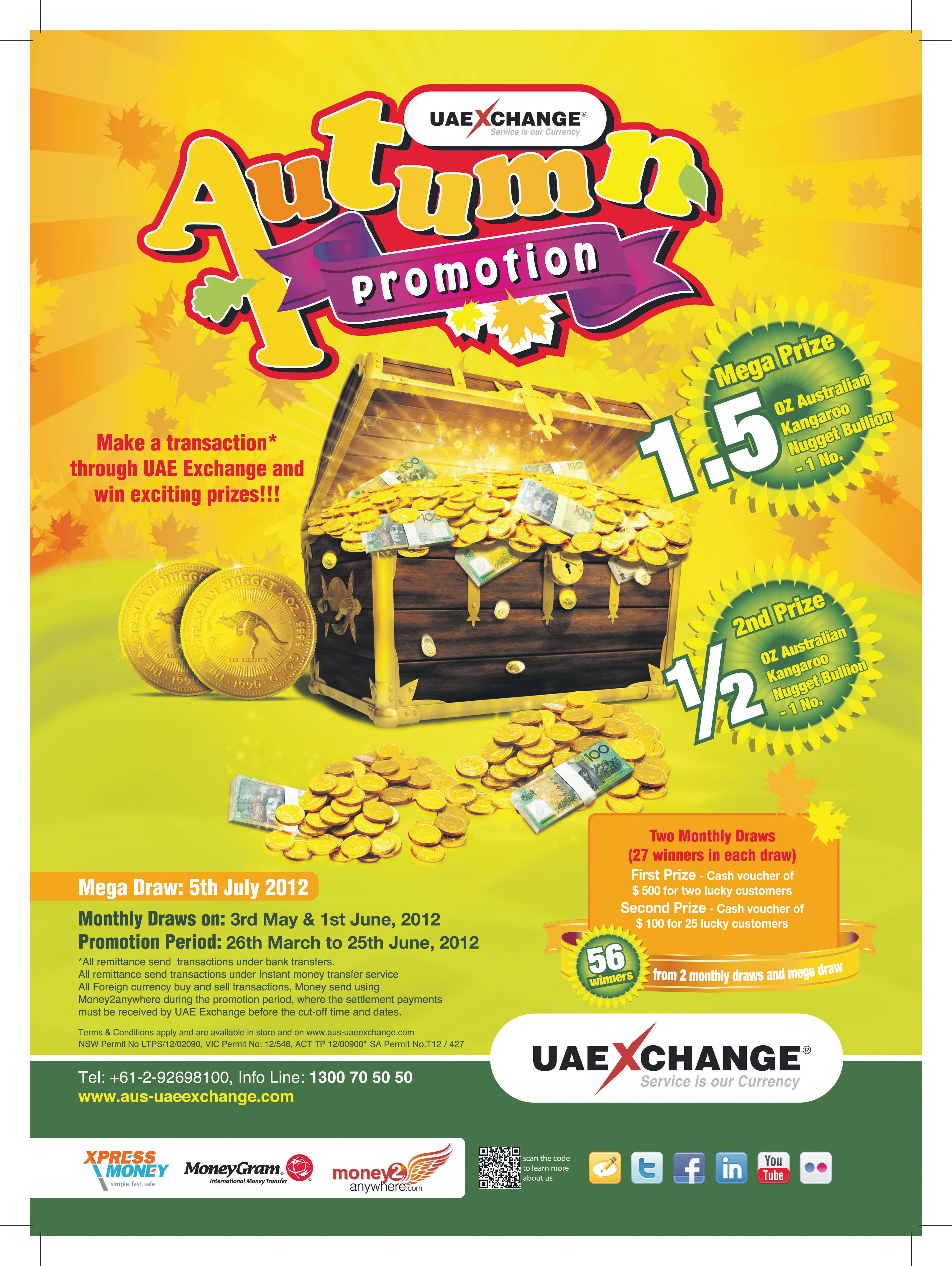
Perhaps to Shah Rukh Khan’s intense annoyance, the Kolkata Knight Riders victory seems to be overshadowed, and unthinkably, by another sport. And not any of the ones that involve a ball, but brains! It’s very likely galling to the vociferous KKR! But the rest of the nation, including some stalwarts in Kolkata, rejoice in the triumph of World Chess Champion Viswanathan Anand, who won the title for the fifth time, beating Israeli challenger Boris Gelfand in the tie-breaker in Moscow on May 30.
India, with its usual exuberant enthusiasm for anyone who performs well on the international arena, has quietly overwhelmed Anand with praise, felicitation and fanfare. From Prime Minister Manmohan Singh to Tamil Nadu Chief Minister J. Jayalalithaa, the accolades have been flowing in for the shy Anand, who has also been gifted Rs 10 lakh from the union sports ministry, as announced by Sports Minister Ajay Maken.
Anand is also being highly recommended to receive the Bharat Ratna, India’s highest civilian award, but it is for the Prime Minister to make a decision on this.
India’s five-time World Chess Champion Viswanathan Anand won the title for the fifth time, beating Gelfand 2.5-1.5 in the four-match tie-breaker. And with this win, India’s chess legend can rightly lay claim to be one of the all-time greats in the sport.
Widely considered as the greatest Indian sportsman, the 42-year-old Anand has been among the game’s elite for more than a decade and a half. The latest world title comes as an icing on the cake for Anand, who also established himself as the world’s best rapid chess player in the tiebreaker.
Anand first won the World Chess Championship title in 2000 beating Latvian Alexei Shirov in Tehran in 2000. He then followed it up with wins in 2007 (Mexico), Bonn (2008), Sofia (2010) and now Moscow (2012).
The win adds lustre to his six chess Oscars. Anand has won the Chess Oscar “an award given by polling votes from the global chess fraternity, including players and best writers across the world”, a record five times with the wins coming in 1997, 1998, 2003, 2004, 2007 and 2008.
Anand, who learnt the game from his mother, Susila Viswanathan at a tender age, learnt the nuances while following the game in Manila, Philippines, where his father, R. Viswanathan, a senior railway officer, was posted for some years in the early 1980s.
Anand’s early success in the sport came in 1983, when at the age of 14 he stunned the field with a nine out of nine perfect score while winning the National SubJunior Chess Championship.
A year later he became the youngest Indian to win the International Master’s Title at the age of fifteen in 1984.
By 16, he was the National Champion and he won it twice more and then concentrated on becoming a champion at higher international levels.
Playing his moves at great speed, he earned the nickname of ‘Lightning Kid’ and also ‘Tiger from Madras’ and in 1987, he returned to Manila, to win and become the first Indian to win the World Junior Chess Championship.
In 1988, at 18, he earned three Grandmaster norms within a span of less than 12 months and in December, he became India’s first Grandmaster.
Then followed Anand’s spectacular rise in world chess.
Anand’s first big moment came
at the Reggio Emilia tournament in 1991 where he finished ahead of Garry Kasparov and Anatoly Karpov and signalled his arrival on the world stage.
In 1991, Anand lost in a tiebreaker to Anatoly Karpov in the quarter finals of the FIDE Knockout World Chess Championship.
Anand also played in the Kasparov-promoted Professional Chess Association and reached the final, losing to Kasparov in New York City’s World Trade Centre. After eight draws, which was a record for the opening of a world championship match, Anand broke through with a win in the ninth game.
But then the more experienced Kasparov hit back and won four of the next five games, and went on to win the match 10.5-7.5.
In 2000, with Kasparov and Kramnik staying away, Anand’s win at the FIDE World Championships in New Delhi and Tehran did not impress the chess fraternity, which still considered the classical match-play as the real world title.
But on the tournament circuit, Anand continued his domination in various forms, winning Advanced Chess tournaments in Leon, Spain, the Chess Classic of Mainz, where he won the title 11 times.
His five successes at Wijk Aan Zee have been a record, and he has also won in Dortmund and Linares.
In 2007, he won the LinaresMorelia with the world’s top players in attendance, though Kasparov had retired by then. The tournament was played to crown the undisputed world champion and Anand was finally the one.
Then with critics still claiming Anand had not won a title in match-play, he came up against Kramnik, who had dethroned Kasparov. Needless to say, Anand won and claimed his title in matchplay, becoming the only player to have won the world title in three formats.
Apart from five Oscars, his other awards include the Arjuna award for Outstanding Indian Sportsman in Chess in 1985; the Padma Shri, National Citizens Award and Soviet Land Nehru Award in 1987; the inaugural Rajiv Gandhi Khel Ratna Award, India’s highest sporting honour in the year 1991-1992. He has also now been nominated by All India Chess Federation (AICF) for the Bharat Ratna, the highest civilian award.
Over the past fortnight, Anand had to fight it hard against Gelfand to retain the title for the third time and in the press

conference following the win, Anand admitted that he was still too tense to rejoice in his victory. “Game one was a tense start. It was a long and tough match. The match was very intense, I am relieved. I was better for most part in the second game. It was a back and forth game. The match was so even that I had no sense of what shape tiebreak would take. Right now the only feeling to have is relief,” Anand told reporters in Moscow after winning his third straight title at the renowned State Tretyakov Gallery.
The tournament went into the tie-breaker after Anand and Gelfand drew the 12th game on May 28. They were tied 6-6 after the final round.
Anand went ahead in the tiebreaker after winning the second game in 77 moves following a draw in the first. The first game ended in a draw in 33 moves. The remaining two games ended in draws. It wasn’t any easier as Gelfand was a tough competitor. But with determination, courage and perseverance, Anand came through and walked away with the title.
So is Viswanathan Anand, World Chess Champion for the fifth consecutive time worthy of a Bharat Ratna? We certainly think so!
 BY RITAM MITRA
BY RITAM MITRA

In the first three seasons of the Indian Premier League, the Kolkata Knight Riders was the laughing stock of the country, and indeed the cricketing world. Until last year, it was the only team to have never reached the semi-final stage, and even then it never seemed likely that they would take the title. It was a sweet victory then, for Shah Rukh Khan’s men, as they took out IPL 2012 in a comprehensive win.
From the very first edition of the IPL, Kolkata were an enigmatic team, fun to watch at the best of times, but positively frustrating at the worst. The glitz and glamour is still there (how could King Khan let it be any other way?), but importantly, it now plays second-fiddle to their cricket. The auction strategy itself showed their desire for a change in direction – Kolkata released all of their players in 2011 and forged themselves a brand new team.
The big story of the season began off the field, of course – as has been the case far too often with the Indian Premier League. Sourav Ganguly, the Prince of Bengal, had moved to the Pune Warriors as captain of the franchise. Split loyalties were but a formality, as was the case when Ganguly was ejected from the Indian team during Greg Chappell’s reign as coach, and spectators at Eden Gardens cheered South Africa on in their comprehensive thrashing of the hosts.
The conflict between Shah Rukh and Ganguly was wellpublicised and brought the actor a torrent of unwarranted criticism – for at the end of the day, the Prince of Bengal failed to notch up a half-century in the entire season, and scored at the lowest strike-rate and average for any batsman with more than 200 runs. However no cricketer, and perhaps no sportsperson in the world commands as much respect and adoration as Ganguly does in Kolkata. Even Sachin Tendulkar has been booed at the Wankhede stadium in Mumbai. Ganguly, though, carries with him an aura that stretches back to his days as captain – Ganguly was, and always will be, treated like royalty. From a Kolkata fan’s perspective then, it was purely absurd to have Ganguly captaining the Pune Warriors. Many had torn allegiances – if Pune won, Kolkata fans would rejoice in Ganguly’s happiness; it was as if Kolkata was just another hometown for Pune.

The Knight Riders started with a couple of underwhelming losses, which were exemplified further by the fact that Pune won three of their first four matches. Ganguly’s batting had left much to be desired, but after picking up two wickets in a crucial spell against Delhi, the eventual tabletoppers, Ganguly ran around the field like a schoolboy; his passion will forever be unquestionable.
Unfortunately for Pune, that was as good as it got – they lost each of their last nine matches, including both of their highly anticipated grudge matches against Kolkata. Kolkata, meanwhile, only got better as the season progressed. They were the most consistent team throughout
the group stages, hampered only by problems with the middle order.

Gautam Gambhir and Jacques Kallis were both in stunning form; however, it was little-known West Indian spinner, Sunil Narine, who stole the show and was named the Player of the Tournament. Narine confounded batsmen with his variations, and took 24 wickets, one less than tournament leader Morne Morkel, at the extraordinary economy rate of 5.47. The only other bowler with an economy rate less than 6 in this edition was none other than Lakshmipathy Balaji – Kolkata’s frontline seamer, who played a pivotal role throughout the tournament until injury saw him benched for the final.
The hallmark of the season for the Knight Riders is that there were very few highlights to speak of, in the most widely used sense
of the term. The team peaked only towards the back end of the tournament, quelling a vicious Delhi batting line up and then only scoring their highest score of the tournament in the final against Chennai. The only highlight Kolkata can point to is consistency – and perhaps the national team can take note of this.
Looking at the bigger picture, Gautam Gambhir led an outfit that will challenge strongly at the Champion’s League later this year. He also again pressed his own claims for leadership duties at the national level, having been unceremoniously dumped from the vice-captaincy earlier this year when selectors gave Virat Kohli the honour instead. It will have been a nice personal victory, then, for Gautam Gambhir to lead a team against his national captain in MS Dhoni, and come away on top.
Gautam Gambhir and Jacques Kallis were both in stunning form; however, it was little-known West Indian spinner, Sunil Narine, who stole the show and was named the Player of the Tournament.
Dear Friends,
On 5th June the Reserve Bank of Australia (RBA) have further decreased interest rates by 0.25%. As you are all aware, last month they slashed the rates by 0.50% and most of the banks passed on the benefit (not in full) to the customers. It will be interesting to see what the lenders pass on. It has become a kind of trend now that the lenders do not pass on the full rate cut as announced by the RBA, as you all know that there are only four major lenders in Australia and therefore we have very little competition which means that we are all at the lender’s mercy when it comes down to the rate cut, there is no doubt that the funding costs have gone up after the global financial crisis however if you look at the profits made by the banks, I actually think that they should be passing on the full rate cut. Australian economy too has started to see some downtrend lately. The share markets all over the world have gone down in the last couple of weeks and our market has reacted to the same and that is why I presume that the Reserve Bank made this move. Australian shares hit a six month low at close of business on 4th June, wiping approximately $23 billion from the share market.This teamed with the recent drop in national house prices, forced the Reserve Bank to cut the cash rate 25 basis points to 3.50 percent. A representative from RP Data has commented- “Our latest index data showed capital city home values fell by 1.4 per cent over the month of May which is a factor the Reserve Bank would have been conscious of when deliberating their interest rate setting,” “Such a significant fall over a single month was unexpected considering the cash rate was slashed by 50 basis points in the same month. Not only did home values fall further in May, but we also saw consumer sentiment remain fairly steady suggesting the May rate cut has had little effect in stimulating consumer confidence and spending. The rate cut today will provide a further boost to housing affordability, which the RBA has recently suggested is back around levels not seen since 2002. The big question now is how much of the rate cut will be passed on by the banks privately and whether this will be enough to provide a shot in the arm for the housing market. If you want to keep abreast with the information, please subscribe to our free news-letter by logging on to our web-site www.gainhomeloans.com.au and enter your details there alternatively you can always reach me on 02 9676 3417.

Contact us to discuss your situation. As we deal with all the lenders, it becomes very easy for you to compare different loans from different lenders. The last thing you want is to hop from one bank to the other trying to understand the products, features and interest rates and more over wasting your valuable time. We make it very easy for you to get the best product to suit your situation and can provide service at your home or at our office, which ever suits you. Our services are absolutely free. We may even get you some fees or charges waived from the bank. But that is not the only reason people choose us, we look after your financial needs from the time of the application, to the settlement and for the life of the loan. We have a regular news-letter that goes out to all our clients which is full of information about property and finance market. You might have noticed that the lenders these days have started offering better rates on home loans. If you recall during the GFC the cost of funds for the banks went up high and they started increasing rates out of RBA interest rate cycle. The information what we are getting lately is that cost of funds to the banks have gone down and now they are in a position to give more discounts to the customers. This is where we as mortgage brokers can assist you to pressurize the bank to reduce your rates further and save you good amount of money on your mortgage. We are in a position to bargain on a collective scale because if the banks do not listen, they lose considerable amount of business which can go to their competitor. I have been doing my bit by sending requests on my clients’ behalf and in most of the cases getting them a better rate. If you want to find out whether you are eligible for a better interest rate than what you have now, please give us a call, we will negotiate with the banks on your behalf and will do our best to get you the best rate and the product, our services are absolutely free

Our services are absolutely Free. Don’t forget, we provide Free Property Reports, which can potentially save you thousands. You are more than welcome to send me an email to nsmatta@gainhomeloans.com. au and order a free property report for a suburb or a particular property. The website address is www.gainhomeloans.com or call me if you need to discuss in detail. Contact us at GAIN HOME LOANS,Lvl 1, 9 Flushcombe Rd, Blacktown, visit our Website or call us 7 days a week on 02 96763417. Disclaimer:





In previous issues I have discussed the health benefits of eating red, green, white and black coloured foods. In this issue let’s see how the yellow and orange coloured foods are beneficial to us. Orange and yellow produce are known to contain flavonoids, zeaxanthin, lycopene, vitamin C and beta-carotene. Orange and yellow coloured fruits and vegetables are usually coloured by natural plant pigments called “carotenoids” Beta-carotene in sweet potato, pumpkin and carrot is converted to vitamin A in its own way by the body, which helps maintain healthy mucous membranes and healthy eyes.

Apricots, though a very small fruit, are packed full of nutrients and are available in fresh and dried form, both of which are healthy and nutritious. Apricots are good sources of vitamin A, vitamin C, beta-carotene, and potassium. These are also a good source of fibre, therefore preventing constipation and diverticulitis. The beta-carotene is good for healthy eyes, especially in preventing macular degeneration.
Dried apricots are a concentrated source of nutrients but are also higher in calories as compared to fresh ones, and therefore the intake should not be more than a handful a day.


Oranges are one of the best sources of vitamin C, a powerful natural antioxidant. Consumption of foods rich in vitamin C helps the body develop resistance against infectious agents and it scavenges harmful, pro-inflammatory free radicals from the blood. In addition to being a very good source of fibre, orange is also a good source of folate, thiamine, potassium, and vitamin A.
Most of us Indians are quite aware of the health benefits of yellow washed moong dal and other yellow lentils. These are quicker and easier to prepare than other lentils and are also light and more easily absorbed and digested.
Lentils are a good source of proteins for vegetarians and when mixed with cereals in dishes such as dosa, idli and khichri, the protein quality of the meal is further improved.

Moong dal is a popular dal in India, Pakistan and Bangladesh. The green gram is soft in texture and does not produce flatulence as some other whole lentils. It is a good source of protein especially for vegetarians, and is low in fat. It is low GI and therefore good for diabetics too, if we do not add too much of oil via the tadka into it. Moong dal sprouts are an excellent source of vitamins C and A. The protein and iron in these is also much more. Added to salads, sandwiches and even paranthas, puris, fruit chaat and bhel puri could increase the nutritional value of these foods.
Papaya is a rich source of antioxidant nutrients such as vitamin C and flavonoids, the B vitamins, folate and pantothenic acid; and the minerals potassium and magnesium; and fiber. It is also an excellent source of vitamin A and flavonoids like beta-carotenes, lutein, zeaxanthin, and cryptoxanthins. Vitamin A is also required for maintaining healthy mucus membranes and skin, and is essential for vision. Papaya contains soluble fibre that helps improve constipation. In addition, papaya contains a digestive enzyme called papain and chymopapain. These enzymes have been shown to help lower inflammation and to improve healing from burns.


Sweet corn is a very versatile vegetable and although being sweet and delicious, it is a great source for many vitamins and minerals such as vitamin B1, vitamin B5, vitamin C, phosphorus, manganese, folate and dietary fibre. It can be used in salads, soups, sandwiches or just on its own as a snack.

Lemon is a must for all households, and is a very good source of vitamin C, which is a powerful anti oxidant and helps in preventing scurvy. It also strengthens our immune system and helps to prevent infection.

Lemon juice has an acidic taste due to the citric acid contained in it, but it leaves an alkaline residue which is very effective in preventing acidity and gastritis. Lemon also aids in digestion of food.
Lemonade is a great thirst quencher for summer and lemon is also a very healthy replacement for salad dressings and marinades.
Pumpkin being a good source of vitamin A, potassium and fibre and low in calories, is not only a symbol of Halloween but also a nutritious food. Pumpkin pie is also a traditional Thanksgiving meal in America.
Sweet potato, having a lower GI than regular potatoes, is considered to be excellent sources of carbohydrates and beta-carotene. In some studies, sweet potato has been shown to be a better source of bio available beta-carotene than green leafy vegetables. Anthocyanin and other colour-related pigments in sweet potato are quite valuable for their anti-inflammatory health benefits.


Carrot contains one of the highest amounts of beta-carotene of all vegetables. Therefore it is an excellent antioxidant. Also, it is a good source of fibre, vitamin B1, vitamin B2, vitamin B6, vitamin C, vitamin K, biotin, potassium, and thiamine. The Vitamin A of carrots helps to keep eyes healthy. The health benefits of different foods, no matter what their colour, play an important role in our health and we cannot single out any particular colour over the other. Therefore try to include different coloured foods in your diet every day to enjoy the best of health.

The wide choice of produce in yellow and orange can give you even more nutritional benefits

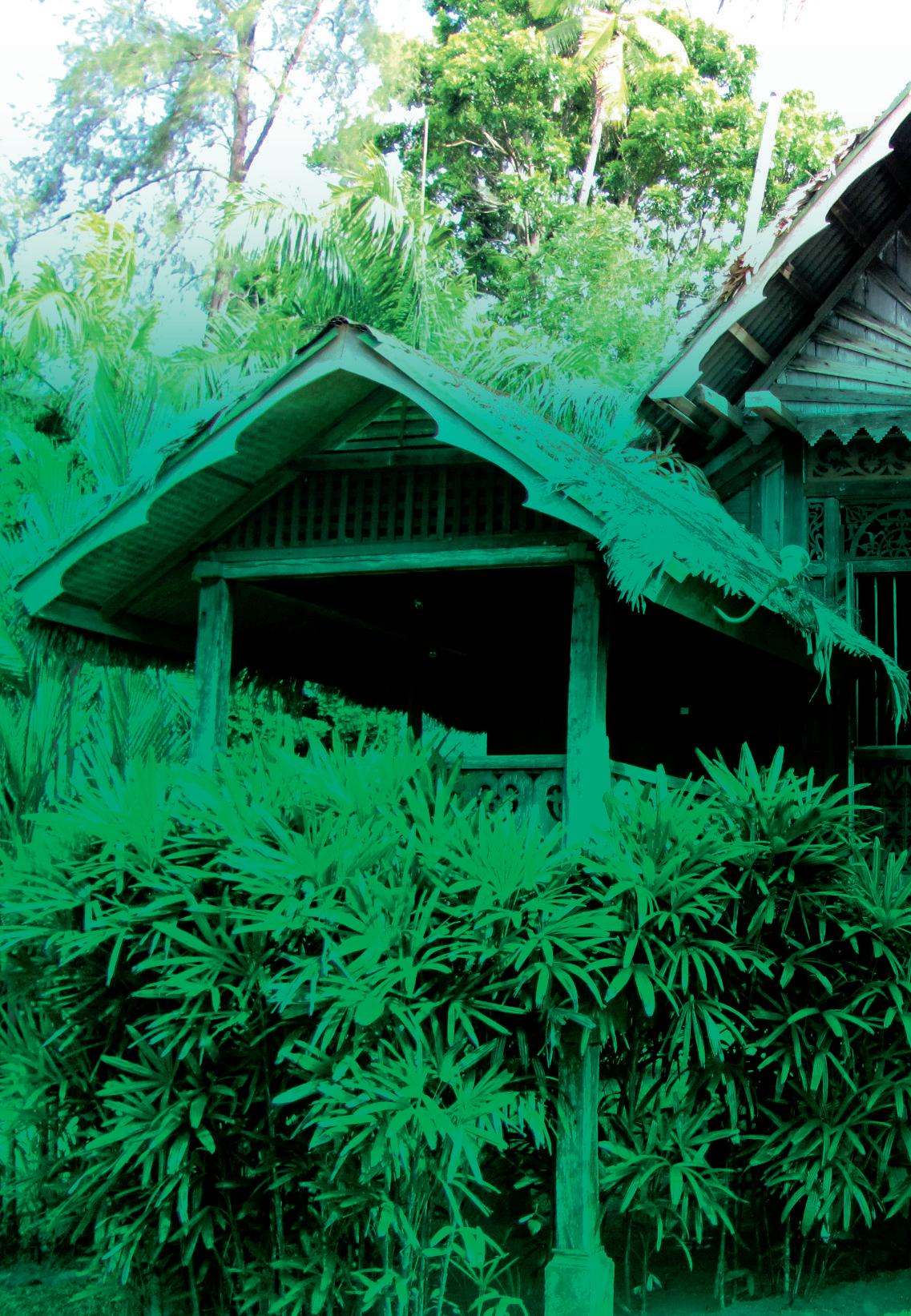 BY PETRA O’NEILL
BY PETRA O’NEILL
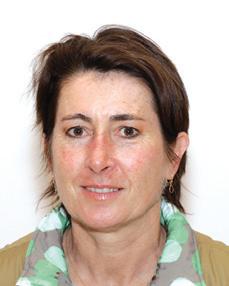
Just a 30km ferry ride from the northwest coast of Malaysia lies an archipelago of ninetynine pristine limestone islands collectively known as Langkawi. The region has abundant wildlife, mountains, caves, waterfalls, lush tropical rainforests, white sandy beaches, night markets offering a spicy array of inexpensive Malay hawker cuisine and some of the most luxurious resorts in Asia. Only two of Langkawi’s islands are inhabited. For centuries, ships brought traders here from Thailand, Malaysia, Indonesia,
and are home to local fishermen and rice farmers. Schools, electricity and roads came only in the 1960s, and Langkawi remained off the tourist radar until 1986 when a former Prime Minister Mahathir bin Mohamad, who had worked there as a doctor, recognized its potential and encouraged investment.
For around $7, you can hop into a small boat to visit three islands – Beras Basah with a beautiful beach and warm jade tinted water, perfect for a refreshing swim; then to watch Bhahminy Kites and Sea Eagles dive for fish; and last to visit an island called Dayang Bunting or “Pregnant Maiden” with hills resembling a woman’s reclining body. A jungle track leads to a crystal clear lake. A macaque monkey crashed through the forest canopy and landed on my

in it and squirted the water out. I ran for dear life to the end of the jetty, took out the wrapped banana that I’d brought along for a snack from the bottom of my bag and tossed it at the monkeys who were following me in hot pursuit. That slowed them down as I made my escape!
The next day I hired a taxi to explore the beautiful beaches to the north of the island. The Andaman and Datai hotels in a lush, primary growth rainforest setting, share a private secluded crescent beach of white sand and crystal clear turquoise water.
The Datai was Langkawi’s first luxury hotel and a naturalist’s paradise with a multitude of birds including kingfishers and hornbills, lizards, flying squirrels and tarantulas. I was ferried around the vast resort complex in a golf buggy by an affable staff member

who offered to stop to allow me to look for tarantulas. He seemed disappointed that I found none.
We drove by traditional villages, with mango, papaya and jackfruit trees that are cultivated in neatly tended gardens to Tanjung Rhu, another spectacular beach with a drier, more exposed landscape of casuarina trees. Further on are dense mangrove swamps that protect the coastline.
Telaga Tujuh is a waterfall that cascades through seven limestone pools. You can hike or go by cable car to the summit of Gunung Mat Cincang, Langkawi’s second highest mountain and at 550 million years, the oldest rock formation in Southeast Asia. During the steep ascent the islands of southern Thailand become visible.
I spent time at Pantai Tengah, the main backpacker area at the Sunset Beach Resort, a laidback, relaxed place, where I hired a pushbike for leisurely rides past rice paddies and grazing water buffaloes to explore nearby beaches. Langkawi is a popular destination for Malaysians on holiday and many families enjoyed strolls along the beach, while young couples dared each other to try parasailing.
most well known is that of Mahsuri, a nineteenth century beauty sentenced to death on suspicion of adultery while her husband was off at war with the Siamese. As the blood ran from her veins, it turned white proving her innocence and bleaching the sand white. Her mausoleum is a popular tourist stop.
Hawker markets are held each evening at a different locations by rotation with Sunday being the biggest and most popular. Malaysian cuisine, a fusion of Malay, Cantonese, Indian, Thai and Indonesian, is delicious.
In the neon lit markets it is remarkably varied and incredibly cheap. Sunday’s Padang Matsirat market has the atmosphere of a street fair as tinny music plays and families enjoy meals of seafood, noodles or nasi lemak, rice cooked in coconut milk and served in a spicy sauce.
For the final two nights I splurged at the Temple Tree, owned by Australian Narelle McMurtrie, who also runs Bon Ton Resort next door. Bon Ton is a cluster of eight traditional Malaysian Kampung houses that were rescued from demolition, reassembled and restored. Each is filled with Asian antiques and an eclectic array of knick-knacks and rich woven silk fabrics in a lush tropical garden setting. Temple Tree comprises eight mansions and colonial bungalows
of Chinese, Malay, Indian and Eurasian origin. All are exquisite. Mine had lime shutters, hardwood floors, a massive bathtub and several day beds for relaxation. As I entered my suite a white cat greeted me, and for the duration of my stay, followed me from room to room.
Several months earlier I’d been in Pondicherry, India. My most lasting memory was of a dog who followed close behind me for several hours as I went in search of food for him. I didn’t know what else to do. But this time, I’d researched beforehand to find an outstanding example of responsible tourism, and this was it. The resort promotes the adaptive reuse of Malaysia’s architectural heritage and uses the profits to support a shelter for neglected, abused and abandoned cats and dogs. Tourism can be


GETTING T h E r E
a positive force and a stay here allows you to feel that you have made a worthy contribution.
On my last day there, my taxi driver, Duns, met me before we were to embark on the drive to the port town of Kuah, to catch the ferry to the mainland. He asked if I could reconsider my travel plans and stay for just one more day so that I could be a guest at his daughter’s wedding. He had been preparing for the festivities all week. He handed me a wedding invitation that had his address. Next time you visit he said, please come and meet my family. As I left Malaysia behind on the express train bound for Bangkok, I reflected on the warmth of my stay. Langkawi is a beautiful, safe, clean, inexpensive and welcoming destination and yes, I do miss that cat!
The Datai was Langkawi’s first luxury hotel and a naturalist’s paradise with a multitude of birds including kingfishers and hornbills, lizards, flying squirrels and tarantulas.

Main Image: Bon Ton Resort
Left to Right: Temple Tree poolside
Beras Basah Island
Beras Basah Island
Sunset Beach Resort
Macaque monkeys

Island hopping
a 30-minute walk to the beach, shops and restaurants. Email: info@templetree.com.my; website: www.templetree.com.my
Malaysia
Lumpur from Australia. You can also access Langkawi by ferry from Penang or the mainland. Trains run from Kuala Lumpur and Butterworth, stopping at Alor Star. wh E r E TO EAT
There are numerous restaurants along the main road of Pantia Tengah. The night markets are great fun and allow you to experience the variety of Malay cuisine. At the restaurant at Bon Ton, owner Narelle McMurtrie and her staff cook up a Malay feast that should not be missed, with a host who explains the details of each dish.
AccO mm O dATION
Of the luxury high-end resorts I visited three, the Datai, Andaman and Tanjung Rhu. All are large, quite formal and secluded with beautiful beaches. The Datai offers accommodation in rooms or villas. Email: Datai@ghmhotels.com; website: www.ghmhotels.com The Andaman next door shares the same lush rainforest setting and spectacular private beach. For nature buffs the hotel offers many activities including rainforest walks. Email: Andaman@ theandaman.com; website: www.luxurycollection.com Tanjung Rhu Resort has a lovely 2km long beach. Email: resort@tanjungrhu.com.my; website: www.tanjungrhu.com.my

Set on the grounds of a coconut plantation, both Bon Ton and Temple Tree are charming, relaxed and intimate, more suited to those who appreciate exquisite taste and historic architecture over service, since guests are left largely on their own with a breakfast hamper delivered the night before, perfect for those in search of peace and privacy. It has a setting overlooking bird-filled wetlands beyond the infinity pools that makes up for lack of a beach. Bon Ton’s airy Malay Kampung villas have wide verandahs for you to enjoy tea and coconut cake. Email: info@bontonresort.com.my; website: www.bontonresort.com.my Temple Tree next door comprises 8 historic mansions of Chinese, Malay, Indian and Eurasian origin that are full of character. My suite, the turquoise and lime green Penang House, was beautifully furnished and huge with several rooms that I shared with the resident cat. It is
Guests can visit the clinic and walk the dogs. More information on the animal shelter that cares for neglected, abused and abandoned dogs and cats can be found at info@ langkawilassie.org.au; website: www.langkawilassie.org.au
A favourable exchange rate translates to Malaysia being a bargain destination. There are many clean, great value guesthouses in Pantai Tengah. I stayed at the Sunset Beach Resort, managed by two friendly Malay women. Rooms are comfortable with a path leading along a lush garden to the restaurant and beach. Email: sunset@sungrouplangkawi.com; website: www.sungrouplangkawi.com
There is an absence of public transport on Langkawi, though mini vans do offer transport. Taxis are very inexpensive and my driver Dans was obliging, punctual and courteous. I paid around $25 for the 3 hour island trip and $6 for the airport transfer. Dans may be contacted on 0124769987.
TIPS
English is widely spoken. Water is safe to drink. Rates of exchange are less favourable here than in Kuala Lumpur. Do not carry food when hiking in rainforests.
Australian passport holders do not need a visa to enter Malaysia for a visit of up to three months, provided their passports are valid for at least six months on arrival and they have a return or onward ticket to another international destination. For citizens of India, Sri Lanka, Pakistan and Afghanistan, a visa from the High Commission of Malaysia in Canberra is required. Tourism Malaysia has many brochures and is at Level 2, 171 Clarence Street, Sydney Phone: 02-9299 4441 Email: malaysia@malaysiatourism.com.au Website: www. tourismmalaysia.com.au
Airlines flies to Langkawi via Kuala
Seeking suitable Hindu/Jain match for our daughter, 5’1”, 22 years. Born and brought up in Sydney with Indian family values. degree in IT. working as a Software consultant in Sydney. caste no bar. contact father in Australia on email: rlagrawal55@gmail.com
Seeking suitable match for a hindu Tamil Iyer girl 26 years old (from canberra Australia, never married), IT software, vegetarian, non smoker, non drinker, living in Australia for 20+ years, simple, straight forward upbringing, loves playing tennis, bike riding and quiet in nature. Email details to r.cosmic9@gmail.com
Seeking well qualified match for very fair young looking hindu lady, 54, veg, divorced, daughter living with her. he must be aged 49-55, non smoker with strong moral values. contact lifepartner@hotmail.com.au or 0404 043 904.
Seeking suitable match (from Australia, never married) for hindu girl 35 years, chartered Accountant (non-veg), living in Australia over 25 years, with eastern and western family values.
Please email with all details on ganesh2011v@gmail.com
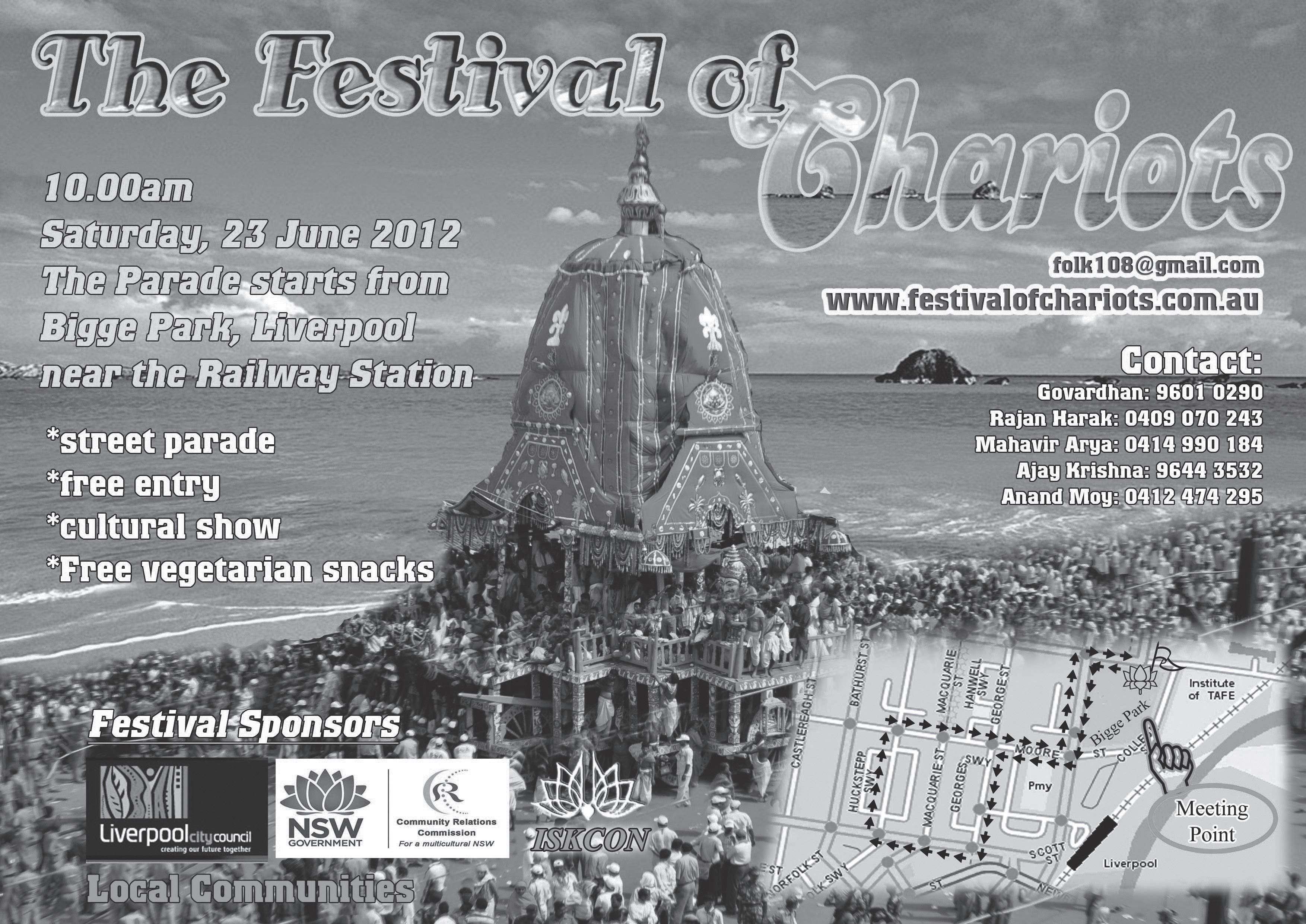
Seeking graduate Hindu girl for well established 5’10”, very fair 21/11/1968 born Australian citizen. Never married. BE(Electrical) self employed. Vegetarian nonsmoker teetotaller. Please email profile with photo to anandrao68@gmail.com
Decent Mangalorean /Goan gentleman 47 years, seeks marriage alliance from sincere attractive South Indian /Sri Lankan/Pakistani / Bangladeshi bride aged 30 – 52, caste religion barrier open. Please contact advertiser by writing or phone – 5/47 First Ave Seven hills 2147.Ph (02) 9676 2512 mob 0458 153 193. Proper address / phone contact and photograph requested.

Seeking suitable match for clean-shaven Jat Sikh Gill boy, 29 years, 5’9”. mSc. BEd (India). diploma in hospitality (Australia). Applied Pr in 2009. Belonging to a noble and respected family with moral values. Sister married and settled in Sydney. Email australiagill@yahoo. com, mobile 0470 574 071, 0423 238 228.
Matrimonial alliance is required for my nephew, 31 years, 5’10”, fair complexion, engineering graduate, working in real estate, from respectable hindu Punjabi family. No dowry please. Simple girl, decent education with any job in Sydney or a professional from India. contact 02 9613-3057; 0423 084 030.
compatible match for 1975 born, handsome clean shaven Sikh Khatri boy, 5’ 9”, two PostGraduate degrees from India and recently finished masters in I.T from Australia. Applied for temporary resident visa (currently with full work rights) and working as Vehicle Service Agent for hertz multi-national car rental company and earning $ 4,000 plus per month. Girl should be tall, well-educated with pleasing personality and must be from Sikh background. Early marriage and serious proposals please. Phone: 042210 2242 or email: jas_ghai01@hotmail.com
equipment. There were diplomas and degrees available to students wanting to take cooking courses.
BY RANI JHALAShe came from a society where women served two purposes – producing the next generation and preparing the next meal. Her great-grandmother did it, her nana did it and her mum did it. As a child, Anita had decided that she was not going to follow either of these traditions.
And she was proud of the fact that she had reached the ripe old age of twenty-five without creating one single dish. Apart from making coffee and heating up pre-packaged food, her only other skill in the kitchen was making toast. In an age when everything was easily available in the supermarket, it was not hard to fulfil her promise.
When she got her dream job as a book reviewer, Anita wrote and maintained the Books 2 Read section of the city’s fortnightly woman’s magazine. She reviewed books from different genres, carefully selecting them from the thousands released each week, knowing that her articles guaranteed them a place on the best-sellers list. This power also placed an immense responsibility on her to give an honest and accurate review.
With the new trend in the entertainment industry of reality shows, it was but natural that these shows would have an impact on the publishing industry. People were either writing memoirs or taking out books in their line of expertise. Gardening, renovations and cookbooks were the most popular of lifestyle books.
Answering a need, Anita found herself seated at the live recording of a reality cooking show.
Yes! A cooking show! She was only there to interview the guest chef as he had recently released an interactive cookbook. It was a novel concept and her editor was determined that they get that first interview. In preparation for the article Anita had read up on a couple of cookbooks and even learnt a few basic cooking terms. She learnt that there were dictionaries that specialised in cookery terms. There were retailers solely dedicated to the sale of cooking utensils and
Anita could not believe that people enjoyed cooking so much that they took it as a subject.


In the years between her childhood and now, ‘they’ had turned cooking into an art where everything had to be scientifically explained and precisely measured.
Anita thought back to her mother’s methods. It was a handful of this and a pinch of that. The food had to taste good. That was the gauge by which a cook was measured. These cookbooks spoke of calories and cholesterol. They categorised foods by the goodness in them, an alien thought for one who judged food on how it looked to the eye and tasted to the palate.
Anita even watched some televised cooking shows, but found herself switching off the television in frustration. How could anyone go so crazy over the freshness of fish, or the availability of a variety of mushroom or the smell of a spice? She wanted to scream back, “Get a life!”
She saw these shows as part of a lucrative business. A billion dollar industry that had been created around man’s natural need for nourishment! Everyone benefitted, from grocery stores to sellers of the produce but most of all, the sponsors. Their products were the first to be bought off the shelves.
Anita had to chuckle when she read how the chef believed that the emotional state of the person cooking greatly affected the outcome of the dish. She had tried so hard to convince her grandmother that this belief was mere superstition, created and spread by men, so that the women of the house felt it was their moral obligation to cook and maintain the mental wellbeing of the family. Here, decades later, man was propagating the same philosophy and the 21st century woman was buying it all over again.
Now seated in the studio, Anita watched with amusement as people rushed around ensuring that all was in working order. The ovens were tested, the ingredients checked and kept ready for the chef to use. Prepared samples of the dish at various stages of cooking were kept ready under the counter, just in case the original did not work out. The contestants were given last minute briefings while the hosts walked through the studio, familiarising themselves
with everything.
The recording started on time. The hosts introduced the remaining contestants and then welcomed the guest chef, Nick Sharlie. While everyone watched Nick enter, Anita watched the contestants. They were awed. The sheer joy of meeting this chef was clearly visible on their faces. He was like a God to them.
“You have to be kidding!”, Anita thought to herself. “For heaven’s sake, he’s just a cook!”
When she turned to finally face the chef, it was her turn to take a deep breath. She had seen his photograph on the book cover, but now standing in front of her was a very good looking man in his thirties. Dressed in dark jeans and a white T-shirt, he spoke in an articulate manner. Anita could not dismiss his looks, but what got her interest, was the love he had for a task that she so abhorred. He was truly enjoying deboning a fish, dicing onions and crushing garlic. He was like a man in love. So totally in love with his cooking, that it showed in his eyes. She had seen that same look in a nun’s eyes as she spoke of her calling, during one of her previous interviews. Anita smiled to herself. What a waste, to show all that emotion for a mere culinary skill. At that very moment, Nick looked up and straight at her, and his eyes showed that he had read her thoughts. The next moment, he turned his attention to the dish in front of him and was once again lost to his art.
Once his recording was over,
Nick’s manager brought him over for the interview, which she conducted at the café nearby. She learned that he had always loved cooking. His grandma has been his inspiration. His prized possession was a family journal with his grandma’s recipes. He had been bullied for opting to taking cooking as an elective in school. That he did not believe the kitchen was either a man’s or woman’s domain, rather it was a shrine for the one who recognised its worth. That every dish he prepared could be made by anyone and that experience gives the confidence to create variations. And that it was this view that inspired his latest project - an online interactive website. Every day, he would put up basic recipe and his subscribers were requested to try variations and post them if they were successful. He picked the best one each day and these were compiled into a monthly cookbook. And he guaranteed that he could bring out the cook in her.
It was here that Anita asked her last question, “What if one honestly and truly does not like to cook. What if one, really does not want to be a chef?”
And Nick replied, “I can’t speak for others, but if ‘you’ don’t want to be a chef, the answer is very simple…” Then a moment later he added, “You must marry one!”
Eight months later at their wedding, she had to laugh when she overheard the conversation between her grandmother and Nick. She was taking down his grandmother’s prized recipes.
Anita had to chuckle when she read how the chef believed that the emotional state of the person cooking greatly affected the outcome of the dish.
He did not believe the kitchen was either a man’s or woman’s domain, rather it was a shrine for the one who recognised its worth.

Living and eating in Australia, it is almost inevitable that cheese will sooner or later cross your path. For the desperately unfamiliar, the white, chewy topping that you find over your vegetarian pizza is also cheese – Mozzarella or Parmesan. If you are used to the standard commercial varieties and our favourite paneer from back home, discovering cheese can be a delight for any foodie, and can enhance your boastful array of hors d’oeuvres at your next social do. Of all the over 1000 varieties of cheese available we are most familiar with Gruyere, Haloumi, Brie, Edam, Camembert, Provolone and the even humbler and more familiar ones like cheddar, Gouda, Colby. Blue cheeses like Roquefort, Stilton, Gorgonzola and the aromatic Limburger are an acquired taste, while Fetta in all its varied flavour is a delightful accompaniment in salads.
Nowadays, cheese can found in different flavours of herbs and condiments, as well as smoked, aged, wood-fired, and many other
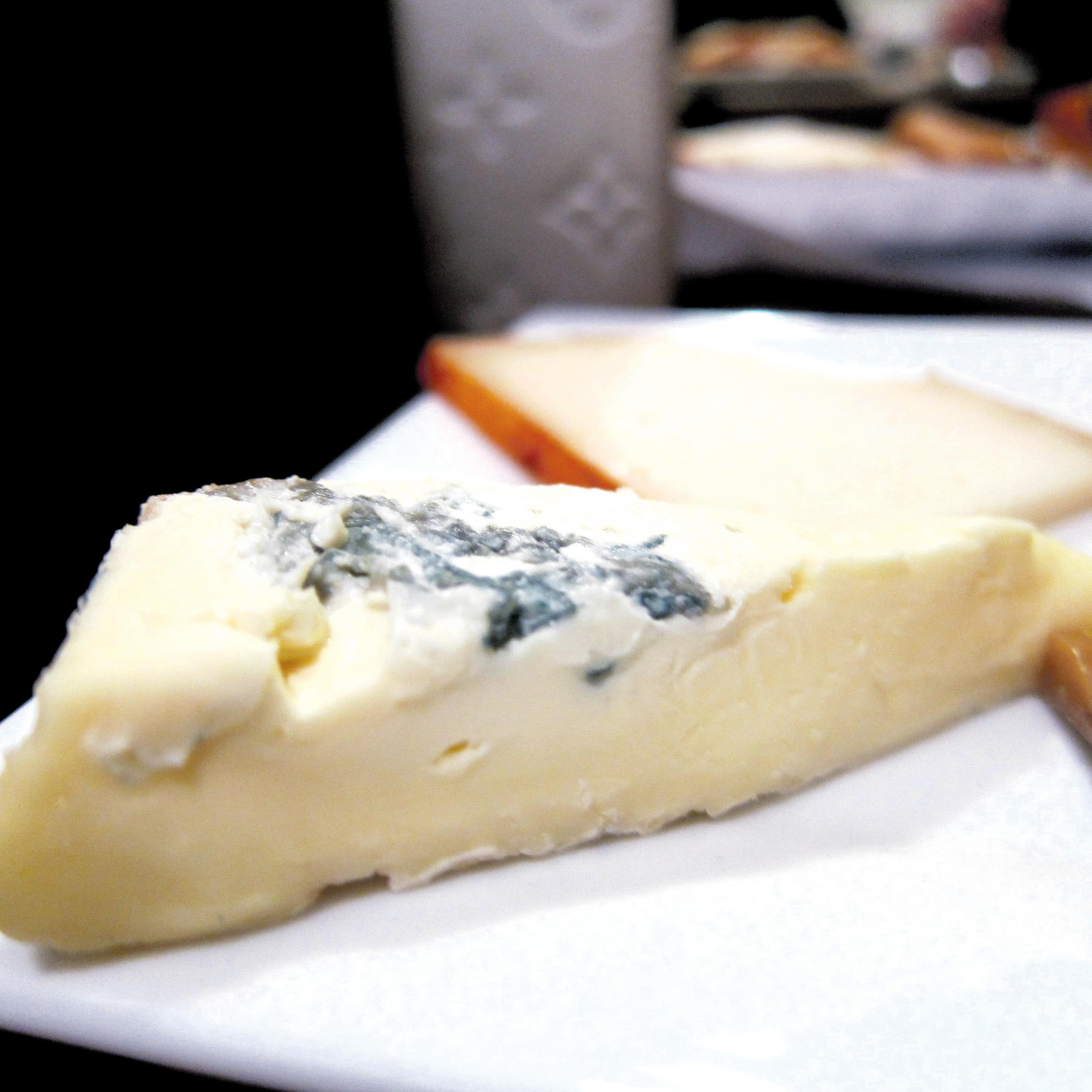
interesting and unique varieties. Cheese is mostly made from the milk of cows, but cheese can be made from sheep, goat, buffalo, reindeer, camel and even yak milk.
Some extremely rare cheese like the one made from moose milk is also extremely expensive, priced at $500 per pound, and is produced in northern Sweden.
Lesser expensive varieties are Gorau Glas, an award-winning, blue-veined cow’s milk cheese from Wales, priced up to $40 a pound, or Bitto, a mixed cow and goats milk cheese from the Italian Alps. A cheese platter with grapes, crackers, olives and other antipasto options accompanied by a good white, red or rose wine can be an epicure’s delight.
Whatever the type, there’s something about cheese that lends itself to cuisines from all around the world. On its own or as an accompaniment, cheese can be an entrée, appetizer, ingredient, and can be trusted to make any meal special.
The recipes below are a mix of the traditional and the unusual, with the option of Indianising them to suit your palate, or dropping some ingredients to retain just basic flavours.
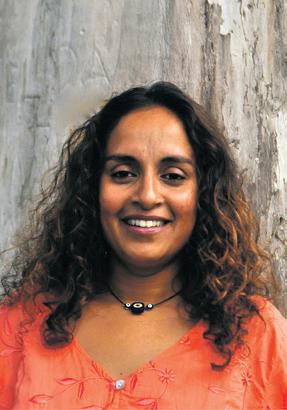
Cheese drops: Crunchy and chewy
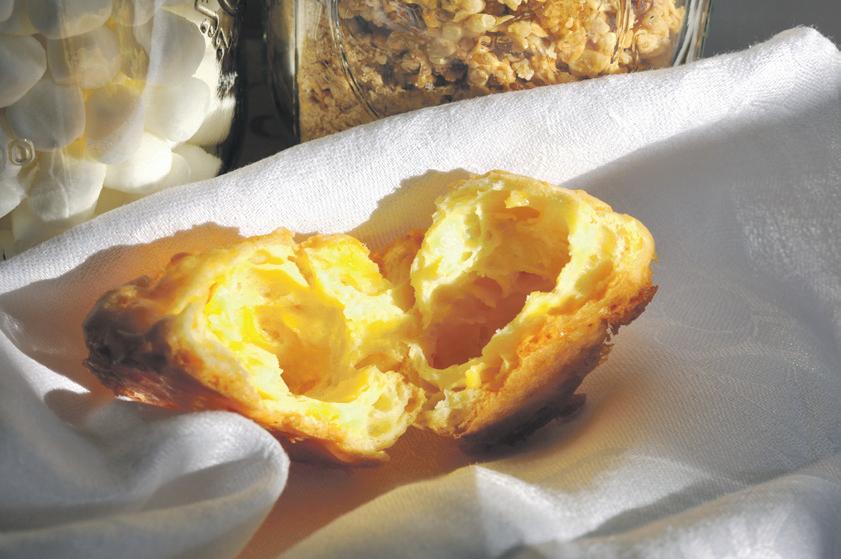
1 cup cornflour
1 cup grated cheese (parmesan, cheddar or tasty)

½ cup milk
1 pinch baking powder
1 egg
1/3 cup breadcrumbs
1/3 cup finely chopped chives
1/3 cup finely cut ham (optional)
1 small garlic pod, finely cut
1 pinch pepper
Salt to taste
Oil for frying
Sift the cornflour into a bowl, then add baking powder and milk, mix gently taking care that no lumps remain. Add egg to the mix, next stir in grated cheese to form a thickish mixture. Add chives, ham, garlic pod, breadcrumbs, pepper, salt and mix thoroughly. Keep aside for 15 minutes. The mixture will expand slightly. Next, heat oil in a deep-bottomed frying pan. Scoop out small circular portions of the mix and drop into the hot oil, deep frying until golden brown. Place on colander for excess oil to drain out, then serve hot.
Paneer burji: An old favourite

200 gms fresh paneer
1/4 tsp cumin seeds
2 green chillies, finely cut
1 small onion, finely cut
¼ tsp turmeric powder
¼ tsp garam masala powder
¼ tsp coriander powder
1 tsp ginger-garlic paste
1 medium tomato, finely cut
1 tbsp chopped fresh coriander
Salt to taste
1 tbsp cooking oil
Place a deep-bottomed pan on high flame, add the cumin seeds and roast lightly. Then add the oil and once heated, add the chillies, onions and ginger garlic paste. Fry for a minute until the onions turn soft. Add the turmeric, coriander and garam masala powders and fry for a minute. Next, add finely chopped tomatoes and fry till they become soft and pulpy, and are fully mixed with the masala. Add grated paneer and salt to the mix and fry thoroughly until the ingredients are well-combined. Garnish with chopped coriander and serve with hot rotis or chappatis.
Blue cheese gougères:


A touch of France
1½ cups water
10 tablespoons unsalted butter
¾ teaspoon salt
2 cups unbleached flour (or bread flour), sifted
5 large eggs
1 cup blue cheese, crumbled
½ tsp freshly ground black pepper
1 egg, beaten
Preheat oven to 180 degrees C.
Butter a large baking sheet and
keep aside. In a saucepan over medium-high heat, combine water, butter, and salt; bring just to a boil and remove from the heat immediately. Add all of the flour at once, to swell the starch and dry the dough. Stir constantly until blended, making sure that there are no lumps. Return pan to heat and continue stirring until the mixture starts to dry out and pull away from the edge of the pan. Remove and let it cool. Add the eggs one at a time, mixing until well blended. The dough should be soft and shiny. Add the blue cheese. Season with black pepper and more salt if needed. Scoop up a tablespoon-full of the dough and place onto the prepared baking sheet; continue until all the dough is used up in cocktail sized puffs. Leave a small space between each as they will expand. Glaze the top of each with beaten egg, dusting black pepper over them, if you wish. Bake for about 30 minutes or until puffed and golden brown. Pierce the top of a gougère to ensure that it is fully baked. The inside should be hollow and dry. Remove and serve warm from the oven.
Available in an astonishing array of options, this nutritious, versatile and delicious food lends its original taste to any kind of cuisine



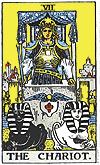

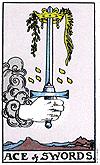
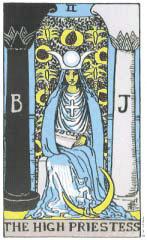
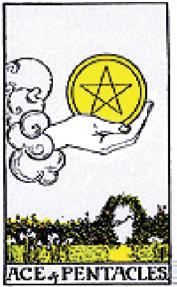
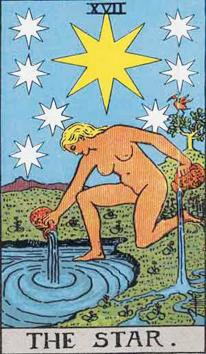
ArIEs March 21 - April 19
This is a great time to do your best in all situations. There is a new energy around you right now and whatever you do will yield amazing results. There will be major changes this month. There will be some friends who will not like the changes in your life. You will feel physically fit too. The cards indicate a bright fresh time to excel and shine.

TAUrUs April 20 - May 20
This month you will feel like you have so much to do and have no time to finish all your tasks. The cards indicate that you may feel pent up, with a lot of things to finish. You will feel at ease after the 20th as there will be more energy around you. There may be money to pay out this month, so be careful.
The cards indicate a time where you will be busy with trying to get your life sorted out. The weeks will feel like months, as this will be a time for lots of work and hardly any play. There is an indication on the cards that you will be looking to move from your current employment. You may take time out to settle your relationship.
The cards indicate that this is a time of great achievement this month, with your work and career on a real high, and opportunities to shine presenting itself. There is also the likelihood of a new romance around you. There is also a time of deep thinking this month about where you really want to be and what you want to do.
LEO July 23 - Aug 22
The cards indicate a great time for you to reap what you have sown, to gather in the harvest of your hard work. Your past efforts are coming to great fruition. Your work and career is going well and you are feeling much happier and more focused. There is more money around you this month. There is also a love interest that you are pursuing.
VIrGO Aug 23 - sep22
The cards indicate a very busy time. Make sure that you keep on top of all your paperwork and even your bills. There is also a sudden trip you may need to take. Do not worry about a relative’s health, things will be fine. Do take care of your own health as you will be very stressed out this month, for one reason or another.
 By NANcy JADE ALTHEA www.nancysood.com
By NANcy JADE ALTHEA www.nancysood.com
LIbrA sep 23 - oct 22
The cards indicate a time of great activity for you. You will be making many changes around your personal and professional life. You are on a mission to spring-clean your life and you will also make some commitments in a relationship. Family may be on your mind as there are some members who are not getting on with each other, leading to stress.
The cards indicate a time of work, as you will be totally engrossed and involved in your job and will find it hard to create time to meet the needs of those around you. There may be legal matters around you or close friends that need to be handled with care, so be alert. You will be thinking about proposing to your lover this month.
The cards indicate a great time for you and your lover. You have decided to make things better and will be making all the right moves to progress your relationship. You have not been as supportive as you could have been of late. Your work is becoming a little stressful, so take time out and make sure you get enough sleep to help you relax.
This month will be all about your security and stability. The cards indicate that you will be doing a lot of financial planning for your future, and it is also indicated that this is a good time to purchase property. You may find yourself in the mood for companionship, so this is a great time to get out there and meet new people.





AqUArIUs Jan 20 - feb 18
The cards indicate a time of great communication and you will receive a letter for which you were waiting. Be patient as you have a lot on your plate and you will achieve what you have set out to do. You may need to go for a medical check up, which is overdue. You will also come to an amicable solution in a romantic connection.
pIscEs feb 19 - March 20
The cards indicate a time of increased spending, you will want to buy presents for your lover. Make sure you buy yourself something nice too, and go for a long swim or walk as you need time to relax and chill out. You have been worrying a lot lately and not sleeping too well. An interesting time is coming up, as you plan for your future.

Poor Katrina Kaif! She’s shooting heavy duty action sequences with Salman Khan in Thailand for Ek Tha Tiger, but instead of spending her time off shopping or lounging by the beach, the actress is training by night for her forthcoming action sequences, which include handto-hand combat, with Aamir Khan, for Dhoom 3
“Aditya chopra has flown in three special trainers for Katrina to get bodytoned for her action sequences with Aamir in Dhoom 3,” said a source, adding that the trainers have to make her look convincing as a combatant assassin in the movie.
And Kabir Khan is making the actress do other kind of stunts in front of the camera as they shoot during the day. An on location source revealed, “It’s two completely different kinds of action discipline for Katrina on camera for Ek Tha Tiger and off camera for Dhoom 3. And it’s sapping her energy. her metabolism is confused - as during daytime she is doing hardcore raw action with Salman, and in the night she trains for highly sophisticated Jackie chan kind of flips and somersaults for Dhoom 3”. Luckily, for the over-exerted diva, she now has some reprieve on the Dhoom 3 front. Apparently Aamir Khan has informed his producers that he is not quite ready for action. So poor Kat can take a break. well, we’re just glad that Kat will feature in her toned, super-glam body on the big screen before long… watch this space!
megastar Amitabh Bachchan and Jaya Bachchan have been married for a whopping 39 years, and they seem a fairly content couple. despite both enjoying celebrity status in their own right and being grandparents, the couple are still going strong and seem to have moulded into a cocoon of affection and caring which should be an example to all couples, young or old. celebrating their wedding anniversary made the Big B nostalgic, as he recounted their wedding day on June 3, 1973 on his blog bigb. bigadda.com
Amitabh recounts that he and Jaya had planned a holiday in London to celebrate the success of Zanjeer, but his father harivansh rai Bachchan wanted them to get married before going on the vacation.
“Zanjeer had just released. And Jaya and I and a few dear friends had decided that if the film did well we would all go to London for a holiday. After a few anxious days on the results of the box office, it was time to put our decision ‘in line’. So I told my parents, who I had now invited to come and live with me, as is the culture in our land, about our decision. And my Father came down heavily on me - ‘If you are planning a holiday with this girl, you will have to marry her and go, else your decision is denied.’
“I was an obedient child! I got married the very next day in a quickly organised wedding with family and some dear friends, without any fanfare, and left for the holiday that very night,” he further posted.
Big B says that his wedding was not a lengthy affair.

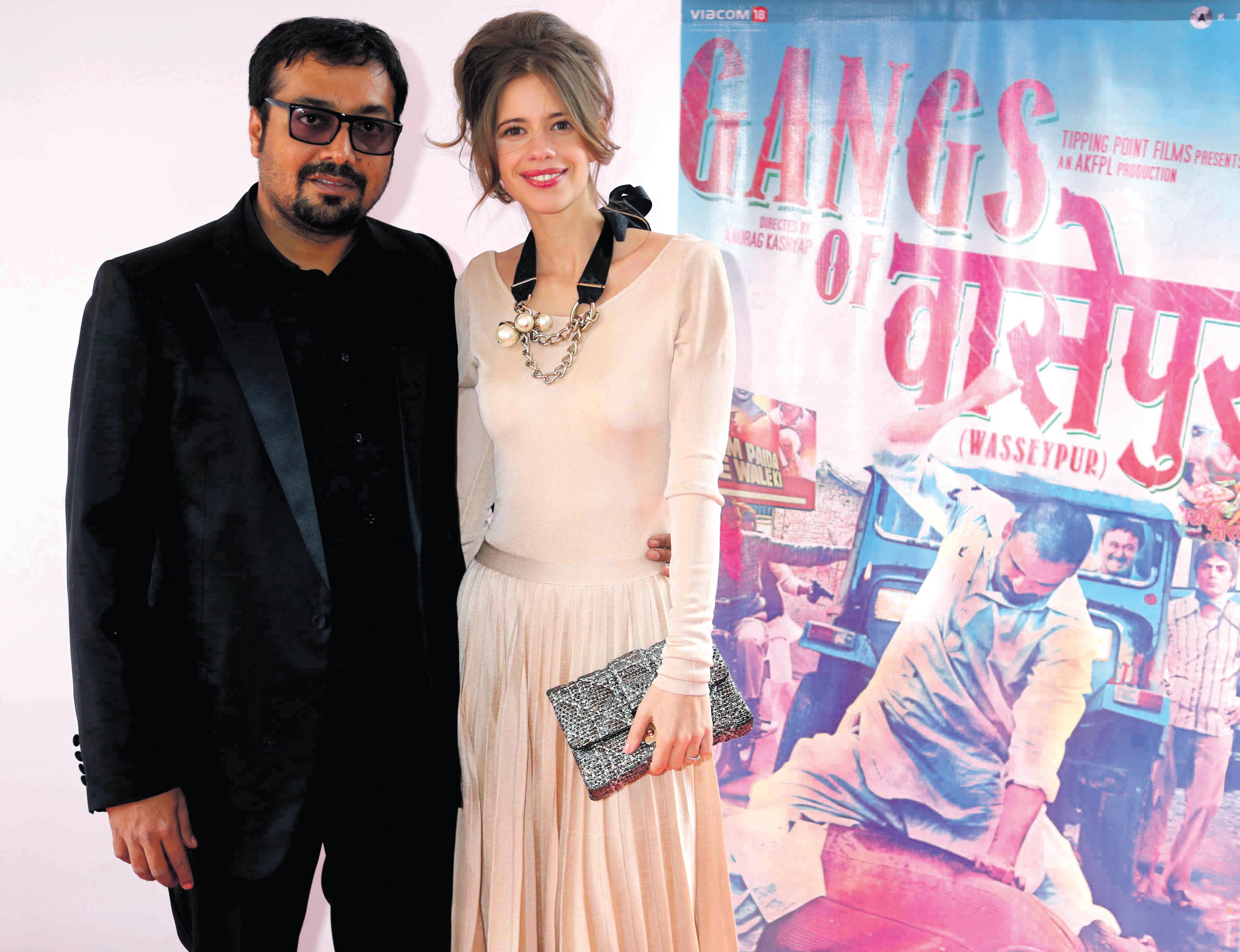
We’re waiting with bated breath for the Sydney Film Fest to screen Anurag kashyap’s Gangs Of Wasseypur. The 5 ½ hour epic, screened in two parts, saw a packed audience at the at its world premiere at the 65th Cannes International Film Festival recently.
eager crowds lined the streets outside the JW marriot hotel at Cannes for the show, while Bollywood celebrities kalki koechlin, ( Anurag’s wife) Huma Quereshi, Richa Chadda and Reema Sen walked the red carpet.
Also attended by kashyap, male actors manoj Bajpayee and Nawazuddin Siddiqui and female music director Sneha khanwalkar, the premiere saw a full house in an 800-seating-capacity hall.
Both parts of Gangs Of Wasseypur, a gritty take on the coal mafia, were screened at the festival’s Directors’ Fortnight, a non-competitive section. Sadly for Sydney fans, director Anurag will not be here to introduce the film. He will be busy with preparations as the film hits the screens in India on June 22.
“ weddings entail great amount of ritual and protocol and decorum and priests and pundits and maulvis. They last for days with great fanfare. Ours was a simple Bengali pundit wedding, exchange of flowered garlands, the mangalsutra, the sindoor and it was all over before the women from Jaya’s side could stop their finger-in-mouth screams of ‘odododooooo’ … or words to that effect,” he added.
ell, 39 years on, the marriage has persevered, their children have become successful and they’re content. The Bachchans have a lot to be thankful about. So good luck and here’s to hitting
They snubbed it as small fry in comparison to the mega bucks doled out for featuring on the large screen, but now Bollywood’s biggies are queuing up to gain mileage on the small screen. Yes, Indian television is coming of age, with
mainstream Bollywood actors, producers and directors taking a long hard relook at this medium for the masses.
Aamir Khan upped the growing trend with Satyamev Jayate, a well-researched show focussing on crucial social issues. Before that, of course, stars such as Amitabh Bachchan, Shah rukh Khan and Salman Khan had discovered the reach of television. however, it was this hardhitting and socially conscious show from Aamir that brought about a change in attitude towards the small screen within Bollywood.
Now we hear that producers Vipul Amrutlal Shah, ritesh Sidhwani and Sanjay Leela Bhansali are planning a bouquet of television shows covering anything and everything from soaps to social issues, reality shows and game shows.
Shah, who is making a comeback on TV after a long gap, explained the movement saying, “ whenever there is a platform, which is strong and powerful, everyone wants to work on that. Everybody recognises that TV is a very strong medium and has grown multi-fold. Its increasing popularity is the reason why people from silver screen are coming on TV.” Shah’s successful past skirmish with TV was in 1999 with Ek Mahal Ho Sapno Ka he has now returned to the small screen, producing Bhai Bhaiya Brother ritesh Sidhwani is ready with a game show for television, teaming up with Farhan Akhtar to bring in a new and enthusiastic audience. Bhansali, too, is keen on bringing his style of lavish filmmaking to the small screenalbeit as a producer of serial soaps. “TV is the most powerful medium today, and it will grow even more powerful tomorrow. I feel it is important for my work to reach out to the homes of the people, rather than people coming to the theatres to watch my work,” said Bhansali, whose film splendorous, to say the least!
YrF TV, a wing of Yash has already done shows like Mahi Way, Rishta.Com, Khottey Sikkey and Kismat looking forward to a long and productive relationship with TV. So now Bollywood’s finding itself in competition with a rival it had long taken for granted. watch out Bollywood, TV-time is here to stay!
Awaara will be aawara
Time magazine may have added Kapoor’s Awaara to the All-Time 100 Best list of the greatest films made since 1923, but Kapoor brothers randhir and rajiv are strictly against remaking this and any of Bollywood legend r films. “we don’t want to touch any of Kapoor’s films,” they said. “we have given up the idea of making a remake of very difficult to reproduce the same magic now”. The showbiz brothers were speaking at a special screening of the movie to commemorate the acting legend’s 24th death anniversary. raj Kapoor died on June 2, 1988, at the age of 63. made in 1951, Awaara was one of the classics which showed Kapoor in the role of a tramp. The film also had Nargis, one of the prime actresses of the golden era.

Even though the hindi film industry has some of the best talent today, the brothers feel that there is no comparison to raj Kapoor.

“There is no actor like raj Kapoor today. People remember him today because of his showmanship. we are so happy that even after 60 years, people watch his films. Till the time people love
has received acclaim from the audience and critics alike, leading Arjun to state that a star surname is not a criterion for recgonition, but good work is. “You are as good as what you do in front of the camera. Nothing else matters, your surname, from where you come or where you will go ... The audience is very intelligent. It gauges you and knows if they want to see you or not,” the 26-year-old said, of his debut in Arjun made his point by citing the Band Baaja Baaraat actor anveer is a prime example of that. Somebody like him came out of nowhere. It just shows
What’s Aish whispering to Abhi here?
Aish: Abhishek, you’ve got to protect me this time – they’re all talking about my weight gain. Can’t you open your mouth at least once and stick up for me?

Pankhuri Goel Champion Lakes WA
Pankhuri wins a double pass to new Hindi film Rowdy Rathore



champions dempo to pick up stakes in the Goa-based sports club.
The King Khan’s interest has excited soccer clubs, who have struggled for recognition from sponsors in a bid to keep the sport alive at a national level. Talks are still in progress, but it’s a tremendous boost and one that is likely to have a domino effect, as other star celebrities begin to emulate SrK, perhaps with the hope that they can emulate his success!
dempo, India’s most successful club in recent times, has an annual budget of around rs.12 crore. But Shah rukh’s involvement will surely be a boon for the club, and will very likely bring in a raft of sponsors. So there is hope for soccer in India, and kudos to SrK for going beyond the cricket.
Rowdy Rathore races on the premise that heroes are made by circumstances, not design. That’s how the street-smart Shiva ends up in a town run by garish goons, where homes, humans and hopes are burnt in effigies mocking human rights.
It is an old-fashioned goodversus-evil comedy-actiondrama with paisa-vasool written in every frame.
Prabhu deva, who earlier directed Salman Khan’s copon-a-rampage saga Wanted puts Akshay on the same page.
To his credit, Akshay manages to create his own world in that Salman-space. Never letting go of that twinkle in his eye, Akshay sinks his crooked teeth into the meaty double role with the warmth, affection and relish of a dinner guest who knows all the yummy dishes on the table have been cooked only for him.
Akshay goes for the sumptuous meal with the hunger of a man who may not see tomorrow. It’s high-octane
performance full of warmth and fury, never over-the-top, even when all hell breaks loose.
The fights are ferocious, but never gut-churning. You can watch the bloodshed with the kids. They’d know, Uncle Akshay is going to win.
The thing about Rowdy Rathore is it never takes itself seriously. The cop and his double won’t kow-tow to the powers-that-be. Ironically, the film grandly bows its head to the Great Bollywood Formula. The dialogues are bombastic, bordering on the corny, nevertheless fun in their intended ideological inferences.
A profound reverence for every trick in the book of filmic formulas sees the accelerated narration to its breathless finale. Even when the going gets gory, there is a tongue-in-cheek humour in the violence.
It’s not the arrogant aggression of Salman in Dabangg or Wanted. In Rowdy Rathore, Akshay creates a new language of heroic aggression. he is goofy, wonky, clumsy and oafish. he has no respect for
the rules of the office. But his character loves doing what he does, because a man has got to do what he has to do, and really someone has to do the dirty job of cleaning up the mess we’ve created.
metal rods from rickety machines are wrenched out and used to teach the anti-socials a lesson. The ‘ouch’ is never unwelcome. Akshay creates a ‘no wince’ situation. whether it’s wooing a Patna girl (Sonakshi Sinha) all over mumbai streets and right into a wedding venue, or in the second half, taking on the vile villainy of a selfappointed lord of diabolism named Baapji (Nasser), who is so uncouth, unwashed and unmannered that he is downright funny in his obscene rowdyism.
The generous splash of colour and music (Sajid-wajid at their peppy pinnacle) pitches the film at a massy level without toppling over into a revolting rowdyism.
Formulistic cinema has never been celebrated with more gusto.
Rowdy Rathore revives the years of Eastman colour cinema
in the 1960s and 1970s, when movies were crazily colourful and rollicking fun, when you knew the villains would get their cacaphonic come-uppance. Pulling out all stops to give us a spicy meal, Prabhu deva succeeds in putting a dizzying spin into Akshay’s double-role act. Twirling his moustache in rajputana pride, romancing the spirited small-town chick or beating up 23 goons with one weapon (self-determination), Akshay delivers a performance that makes you want to jump out of your seat, clapping, whistling and cheering in appreciation. while the fights are brilliantly conceived and executed, it’s Akshay’s courtship with Sonakshi that had me giggling non-stop. If he is outrageously coy in his wooing act, Sonakshi gives him tit-for-tat, matching steps with
FiLM:Rowdy Rathore
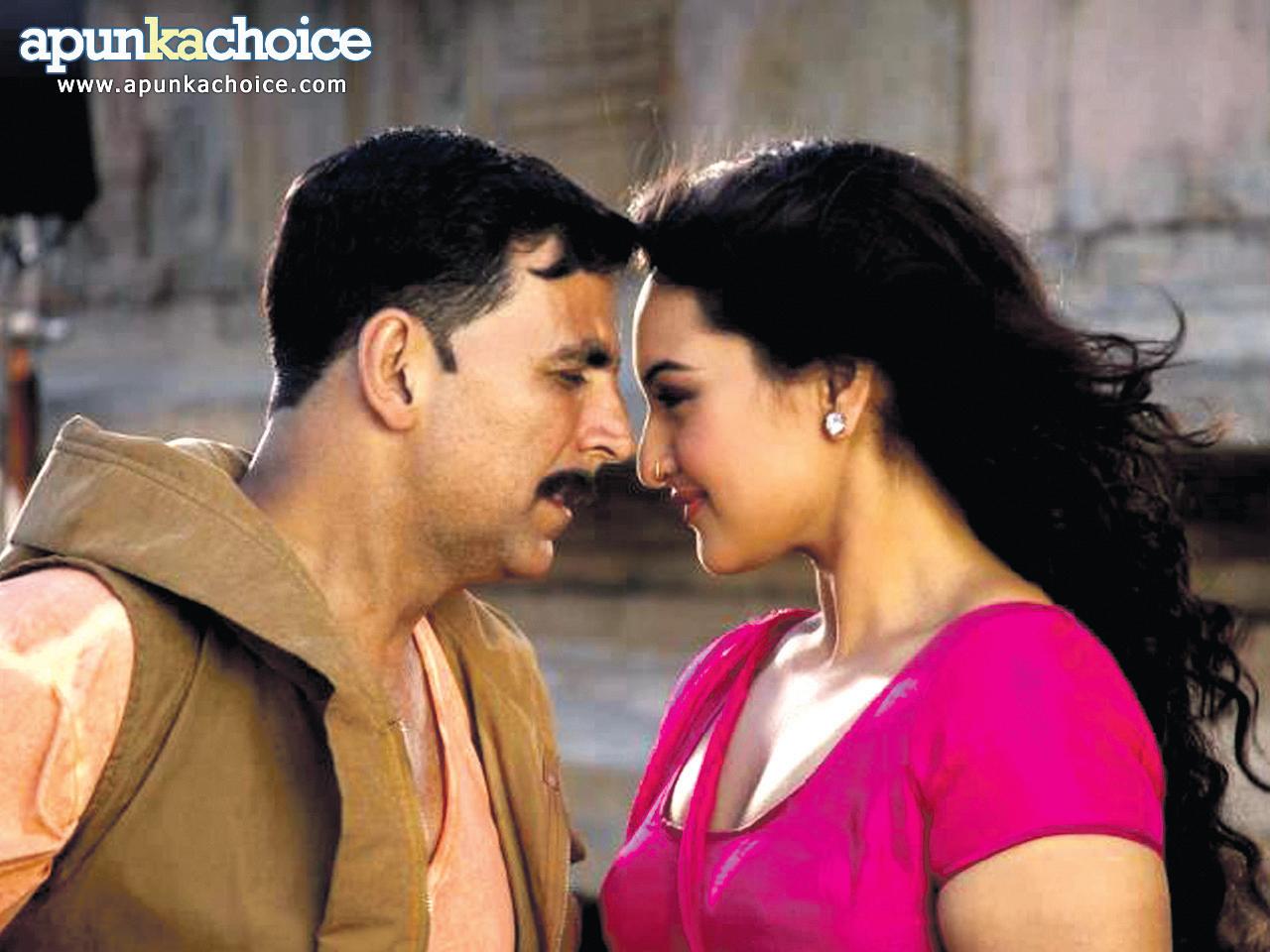
her far more experienced co-star, never letting the age difference daunt her.
The rest of the cast only has to stand around to extol and cheer our down-to-earth superhero cop. All the while, the narration never loses its tempo, warmth or humour.
The choreography ensures that the dances merge with seamless elan into the action. Rowdy Rathore is quite a gravity-defying feat. It often finds the villains being hurled into the air. But the narration manages to keep its feet on the ground. really, Akshay as the angry cop is more entertaining than intimidating.
Three cheers for producer Sanjay Leela Bhansali for coming out of his comfort zone to celebrate the spirit of hindi commercial cinema at its dizziest and craziest.
CAST: Akshay kumar, Sonakshi Sinha, yashpal Sharma
DiReCTOR: Prabhu Deva
Karisma Kapoor’s grand-slam of a return to form (and shape) in Vikram Bhatt’s startling mix of myth and mystery in Dangerous Ishq proves that there is life after 30 for Bollywood divas. You just need to get a life.
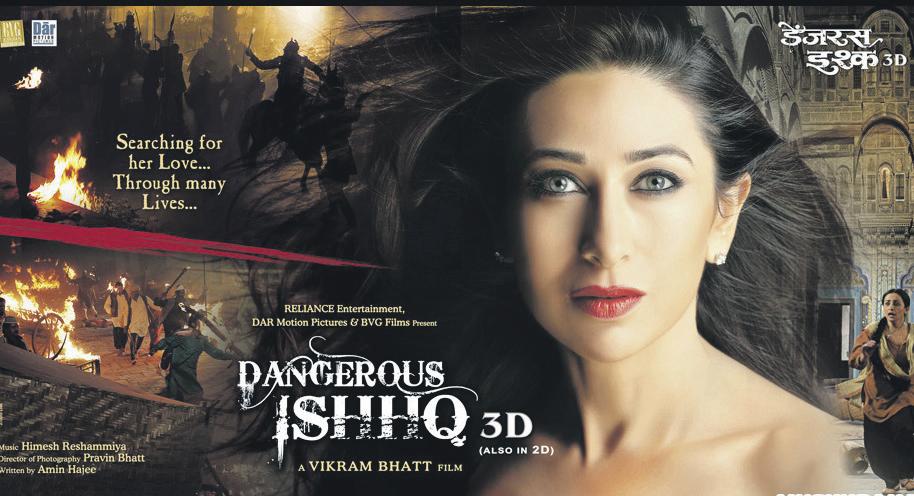
Bhatt, so far consumed in making relatively small films about paranormal experiences, pulls out all stops in Dangerous Ishq to make Karisma’s comeback a near-spectacular cinematic event.
The film told through many eras of tumult, mythology and history engages our attention on many levels. It takes its interestingly-etched protagonist through several lives in search of her missing soulmate. This commodiousepic timeframe stretching from 2012 to the 16th century gives Karisma a chance to slip into several costume changes.
Luckily for her and for the audience, Dangerous Ishq is not only about getting into the right clothes. Amin hajee’s script makes resonant existential statements without getting the plot tangled in ideas and concepts. Beyond a point it ceases to matter whether the audience believes in after-life or reincarnation.
Bhatt’s splendidly executed mythological-thriller just makes you thankful for the gift of mythology, philosophy and cinematic technique that makes a film so daring in concept come alive in flaming colours of pain anger defiance and redemption.
Indeed, this is a film that takes us far beyond the accepted boundaries of entertainment to forge a new genre of cinematic experience where the pauranic katha of Savitri retrieving her husband from the clutches of Yama, the God of
death, is taken to an unexplored level of cinema.
In Raaz, 10 years ago Bhatt had explored the same theme. here, he takes the theme to the arena of the unknown.
From the opening scenes where Sanjana (Karisma) turns back from a traffic snarl on the way to mumbai airport to board a flight for a year of a posh modelling assignment in Paris, to be with her beau (rajniesh duggal), you know when it comes to love this lady means business.
Bhatt gets considerable support from his technicians in building a rugged reverberant artefact that carries the love tale through centuries of strife, blood shed and anguish. The drama is created with a keen eye for heightened emotions.
And yet ironically, Karisma pitches her performance at a subdued decibel. Even when her soul screams in protest at being separated from her eternal lover through four life times, the actress exudes fortitude and restrain. welcome back, Karisma!
Karisma gets able support from a slew of capable actors playing her predatory male adversary in various lifetimes.
rajineish partners her ably. ravi Kissan and Aarya Babbar stand out among the villains who want to separate them.
divya dutta as Karisma’s friend once again proves that she can carry any kind of situation to a believable level.

however, Gracy Singh as meerabai provides unintended laughter.
As for Jimmy Sheirgill, here’s an actor who never lets a script down. here he has a role that reveals several dark shades of psychological trauma as it progresses from investigating a kidnapping to investing in afterlife. Jimmy is every bit in form.
But the film’s real hero is Karisma. She is virtually in every frame.
cinematographer Pravin Bhatt captures Karisma’s lucid face in dazzling shades suggesting an ageless fusion of night and day.
And then there are the 3d effects. Never before in an Indian film have we seen the 3d technique been applied with such resounding impact. The flying rubble, boulders and the dust in the key action scenes actually makes you flinch as they hurl out of the screen at the speed of the film’s excellent sound. miraculously the audience forgets the film is in 3d, as the gripping story takes over, transporting us into several world, moods, emotions and interpretations of love commitment and determination. Indeed Dangerous Ishq is a far greater
achievement than a sum-total of its storytelling and technique. Bhatt creates an audacious heady mix of mythology and the supernatural.
This film could be interpreted as an illustrated graphic novel with the 3d effects being optional. Leave it out, and you are still left with a film that balances many lives in the same line of vision without making the drama a slave to period or costumes.
Bhatt tells it with a deep-throated rush of passion. You may not believe in past lives. But this film sure makes you believe punar-janam has a future in our cinema.
Subhash K. JhaFiLM: Dangerous Ishq
CAST: karisma kapoor, Jimmy Sheirgill, Rajniesh Duggal, Ravi kissan, Divya Dutta
DiReCTOR: Vikram Bhatt
It was that great poet-thinker harindranath chattopadhyay who said: “It’s very simple to be difficult, but very difficult to be simple.” By that logic, debutant director Gitanjali Sinha has pulled off a reasonably admirable feat in this simple straight-from-theheart film about the relationship between a neglected boy Avinash (raj Tandon) and his lonely grandfather.
The film vaguely echoes L.V. Prasad’s 1974 tearjerker Bidaai, though not in any overt way.
That the grandfather who embraces the boy’s loneliness and insecurities is played by raghuvir Yadav is a happy coincidence, and one that fills up the rather austere spaces in the film’s narrative.
The small-town ambience in Bihar, the old sprawling houses with acres of greenery stretching out from here to eternity, furnish the film with a burnished exterior.
As for the interiors, don’t look
too deep. Sinha seems content skimming the surface of the emotions gliding along gently as the boy finds a new beginning in his grandfather’s company.
dramatic conflicts are created through some villainous elements creeping in with embarrassing inopportunity into the placid ambience. The build-up towards a kite-flying contest is negotiated with disarming naivete.
Yeh Khula Aasmaan is an old-fashioned simple and transparent tale told with a straightforwardness that challenges current filmmaking trends of irrelevant complexities. The narration is kept simple and largely formulistic. A romance between the gawky hero and the-girl-next-door (Anya Anand) is teased into the tale. The real hero of the film, besides the smalltown ambience, is raghuvir. he is in his elements, even pitching in with a folk song somewhere
down the line while the youngsters at the helm serve their purpose.
Yashpal Sharma as Avinash’s sophisticated tycoon-father is completely miscast.
Yeh Khula Aasmaan is a well-intended heartwarming film which revels in postures of pristine idealism associated with nonmetropolitan life. There are no heartstopping moments of high and low.

The drama, when it ensues, is brought on with disarming simplicity. That the heart is in the right place is undeniable.
Subhash K. JhaFiLM:Yeh Khula Aasmaan
CAST: Raghuvir yadav, Raj Tandon, Anya Anand, yashpal Sharma and manjusha Godse
DiReCTOR: Gitanjali Sinha
Ihave, in the past through this column, bemoaned the plight posed by PCs and the plastic junk plaguing Planet Earth. I lambasted laptops and demonised desktops. But the harrowing tale of getting rid of the heaps of hardware reaching Himalayan proportions is just a Sunday picnic compared to the sorry saga of storage devices.
My grave concern is the problem we may face, not before long, in accessing vital personal information snugly stored in various storage media and feeling smug about retrieving them any time in the future. Some time ago, owing to my part-time role in a medical practice, I attended a healthcare industry managers’ seminar where the main topic was saving storage space and retrieval of data. Understandably the speakers, sponsored by software vendors, waxed eloquent on computers’ capacity to save you dollops of dollars by shrinking storage space and sparing tropical forests by creating paperless offices. Anyone with any link to the medical industry would know that it is a prolific paper-user and records need to be kept for years and years. Every patient’s portrayal of their pain has to be painstakingly preserved to protect the service provider’s professional integrity and indemnity. Some patients’ paper records where I worked were bulkier than a Harry Potter book. So I had a good reason to attend this seminar in the fond hope of saving storage space and rental dollars for my employer.
At the end of the meeting almost everyone seemed swayed by the smooth talking software spokespersons. Waiting for the Q&A segment to close, the cynic in me dared to dig into my bag of tricks and voice my concerns about the possibility of our securely saved data sliding into a sinkhole, never to be seen again.
In the mid ‘80s, my Apple 2c required five and half inch floppy discs to save data. The X and Y gens may not know what this floppy disc looks like. I have dozens with my personal correspondence, important and not so important, ensconced in them. With the old Apple having lost its core, there is no way of retrieving this data now. I hope anyone I had lent money to doesn’t see this column. I have no
proof that they owe me.

In the mid ‘90s I used the more popular 3 ¼” diskette to store the medical practice data, and we were crunching one disk every few days; so we upgraded to a Zip drive as it zaps data into a more compact mode. But that joy was short-lived since it was no different from its slimmer 3 ¼”

cousin. Does any desktop now come with drives to read these disks? Sadly, no! A chest full of these diskettes lie dormant, hoarding valuable data. They are like the buried treasures of the Thiruvananthapuram temple. I know they are there, but I can’t access them. Next, I migrated to CDs and DVDs, and have dozens of them with critical info of client consults. They are still accessible, but how long will it be before they meet the same fate of the earlier diskettes. But these round shiny shingles have some use. I
hung a few of them in my fruit trees and they seem to scare away the birds.
Now come the flash drives, aka memory sticks. How secure are they? If you unfortunately lose one, all your life secrets are out for the whole world to see.
Much to the chagrin of the speakers I pulled out a file containing handwritten letters, including the last one from my father before he passed away some 40 years ago. Written on Titagur (Orissa) mill paper, I can flip to any piece in that folder in a matter of seconds, with all its contents clearly visible.
Next I pulled out my trump card. A stack of palm leaves the size of Mars bars with wooden pieces of the same size on the top and bottom, serving as protective cover. Written with a stylus, every word on those leaves pops out like a pearl. It is of 19th century origin

given to my grandfather, and passed on to my father. It contains diagnostic details of cattle diseases and herbal cures. My forefathers used it as a ready reference to treat any ailment of the dozens of cows they owned. It is the ‘Sahadeva sastra’. During their year of anonymity, the Pandavas lived under different guises with Sahadeva leading the life of a cowherd and it was his handiwork reproduced. After over a hundredyear life span, all the information on these palm leaves is accessible, legible and readable; whereas my ten or twenty year-old computer disks are museum pieces. So much for technology!
Desktops have gone the way of dodos; laptops are languishing, with Tablets giving them headaches. It is not just the hardware that gives us the hard time. The short lifespan of storage media is a scary scenario indeed.
With the old Apple having lost its core, there is no way of retrieving this data now.
After over a hundred-year life span, all the information on these palm leaves is still accessible, legible and readable; whereas my ten or twenty year-old computer disks are museum pieces.



